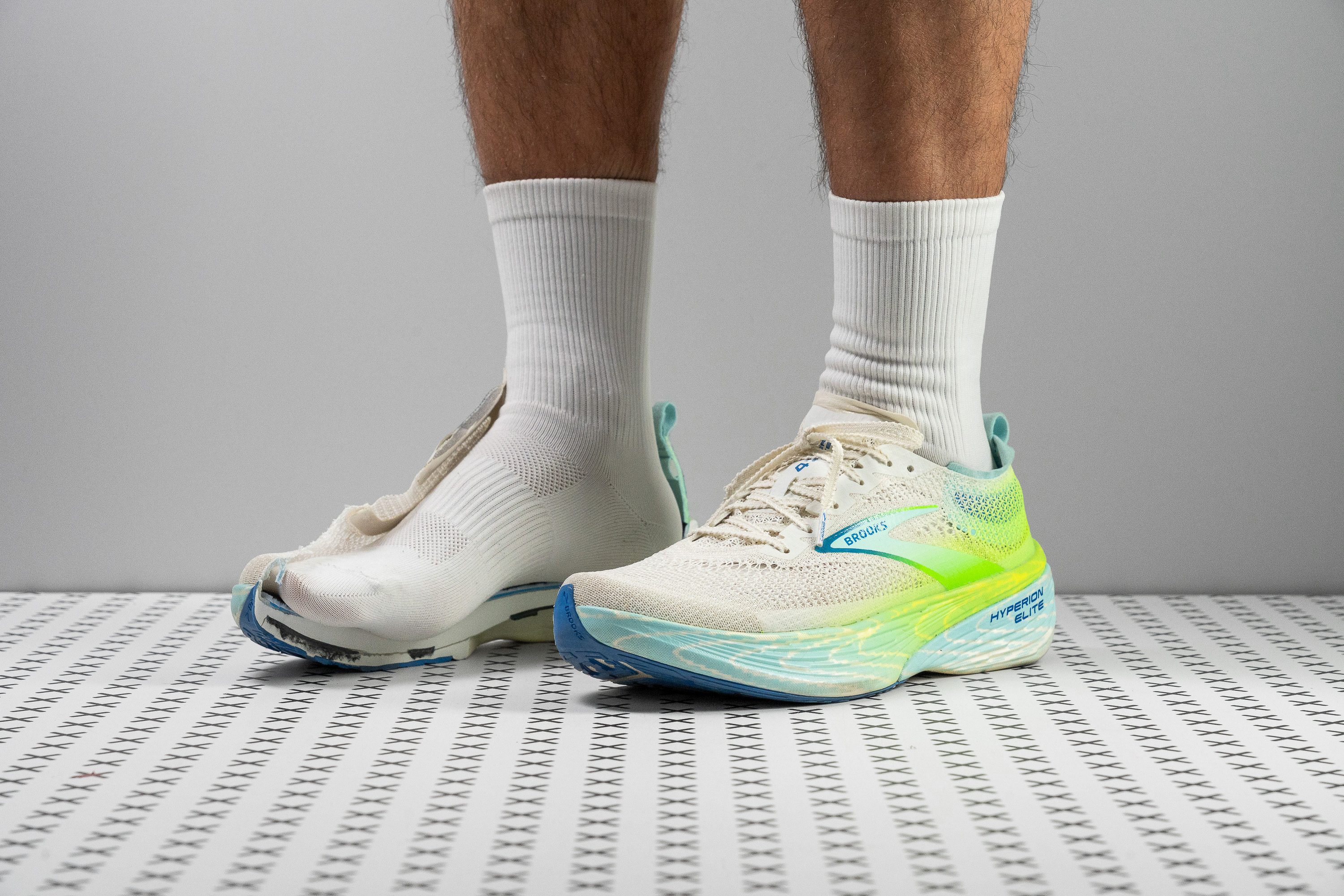Our verdict
Pros
- Exceptionally breathable upper
- PEBA-based DNA Gold foam
- Top-notch durability for a race shoe
- Awesome from 5K to the marathon distance
- Rocker promotes smooth toe-offs
- High drop suits heel strikers
- Keeps same price as non-PEBA model
- Propulsion-boosting Speedvault+ plate
- Propulsion-boosting Speedvault+ plate
Cons
- Not ideal for forefoot strikers
- Narrow, tapered toebox
- Too unstable for some
- Still lacks a bit of energy return
Audience verdict
- Top 25% in road running shoes
- Top 18% in Brooks running shoes
Comparison
The most similar running shoes compared
+ + Add a shoe | |||||
|---|---|---|---|---|---|
| Audience score | 89 Great! | 92 Superb! | 89 Great! | 91 Superb! | |
| Price | £220 | £260 | £220 | £270 | |
| Pace | Competition | Competition | Competition | Competition | |
| Shock absorption | High | High | High | High | |
| Energy return | High | High | High | High | |
| Traction | High | High | High | High | |
| Arch support | Neutral | Neutral | Neutral | Neutral | |
| Weight lab Weight brand | 6.9 oz / 197g 7.3 oz / 207g | 7 oz / 198g 7.5 oz / 213g | 7.8 oz / 220g 7.4 oz / 210g | 7.2 oz / 204g 7.1 oz / 201g | |
| Lightweight | ✓ | ✓ | ✓ | ✓ | |
| Drop lab Drop brand | 11.7 mm 8.0 mm | 10.7 mm 8.0 mm | 10.0 mm 7.0 mm | 11.2 mm 8.0 mm | |
| Strike pattern | Heel | Heel | HeelMid/forefoot | Heel | |
| Size | True to size | True to size | Slightly small | - | |
| Midsole softness | Soft | Soft | Soft | Soft | |
| Difference in midsole softness in cold | Small | Small | Small | Small | |
| Toebox durability | Decent | Bad | Decent | Decent | |
| Heel padding durability | Good | Decent | Good | Good | |
| Outsole durability | Decent | Decent | Good | Bad | |
| Breathability | Breathable | Moderate | Breathable | Breathable | |
| Width / fit | Narrow | Medium | Narrow | Narrow | |
| Toebox width | Medium | Medium | Narrow | Medium | |
| Stiffness | Stiff | Moderate | Stiff | Stiff | |
| Torsional rigidity | Stiff | Stiff | Stiff | Stiff | |
| Heel counter stiffness | Flexible | Flexible | Flexible | Flexible | |
| Plate | Carbon plate | Carbon plate | Carbon plate | Carbon plate | |
| Rocker | ✗ | ✓ | ✓ | ✓ | |
| Heel lab Heel brand | 38.5 mm 40.0 mm | 39.3 mm 40.0 mm | 39.6 mm 40.0 mm | 37.6 mm 40.0 mm | |
| Forefoot lab Forefoot brand | 26.8 mm 32.0 mm | 28.6 mm 32.0 mm | 29.6 mm 33.0 mm | 26.4 mm 32.0 mm | |
| Widths available | Normal | NormalWide | Normal | Normal | |
| Orthotic friendly | ✓ | ✓ | ✓ | ✓ | |
| Season | SummerAll seasons | All seasons | SummerAll seasons | SummerAll seasons | |
| Removable insole | ✓ | ✓ | ✓ | ✓ | |
| Ranking | #83 Top 23% | #12 Top 4% | #98 Top 27% | #29 Top 8% | |
| Popularity | #271 Bottom 26% | #35 Top 10% | #62 Top 17% | #120 Top 33% |
Who should buy
After testing the Brooks Hyperion Elite 4 PB in the lab, we believe that it's perfect for:
- Runners who found past Hyperion Elite models lacking in bounce—this version finally delivers the long-awaited PEBA midsole.
- Anyone seeking a non-Nike supershoe that feels similar to the Vaporfly Next% 2.
- Heel strikers wanting a durable racing shoe with a high heel-to-toe drop.
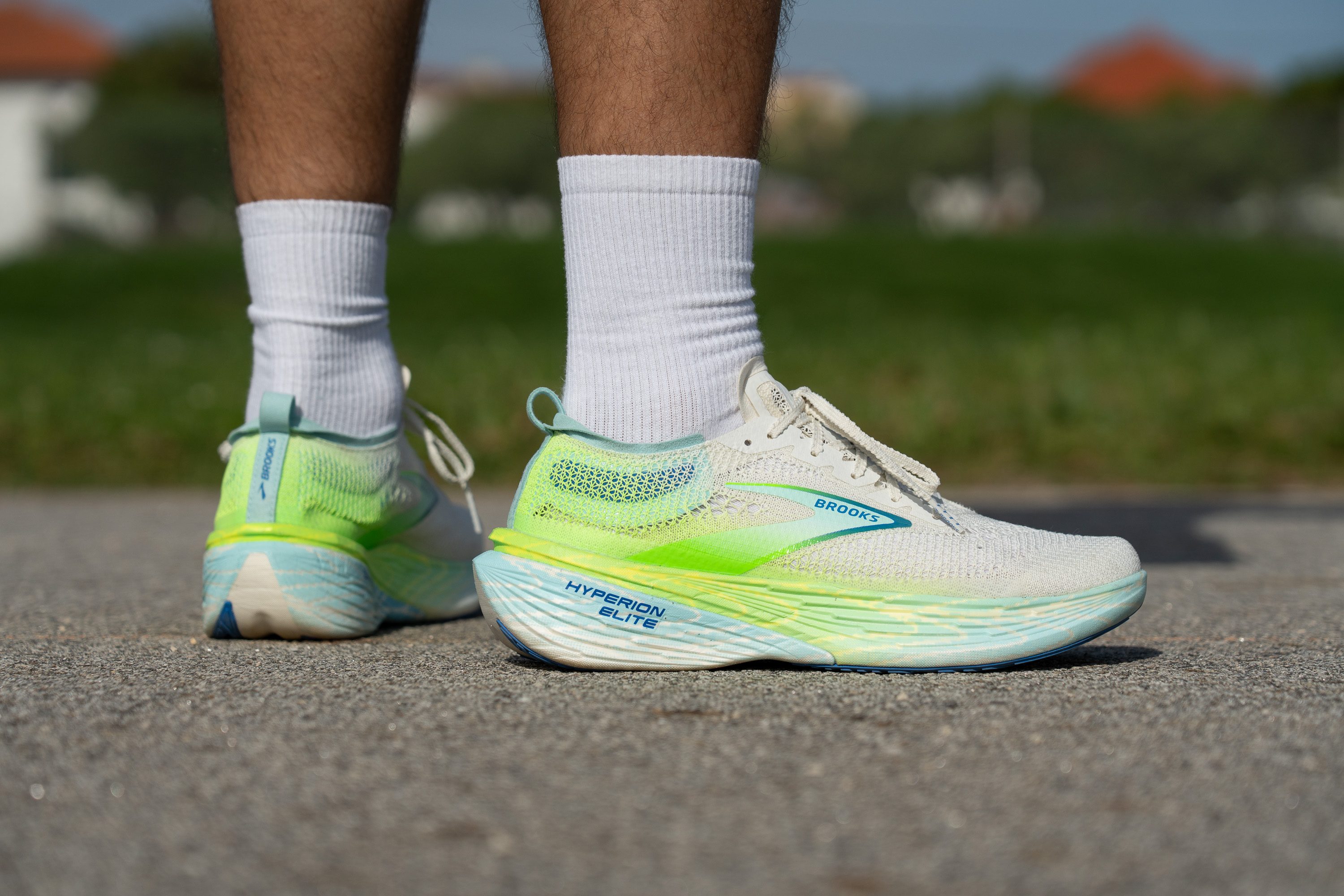
Who should NOT buy
We believe the Hyperion Elite 4 PB isn’t the best option for forefoot or midfoot strikers due to its high drop. From our perspective, a more balanced supershoe like the ASICS Metaspeed Sky Paris or the Nike Vaporfly 4 delivers a much better ride for these runners.
Additionally, we think the narrow toebox limits the appeal of this shoe, especially for marathons or long runs. In our lab, we found that shoes like the New Balance FuelCell SuperComp Elite v4 or Saucony Endorphin Pro 4 offer more toe space while keeping a responsive PEBA-based midsole.
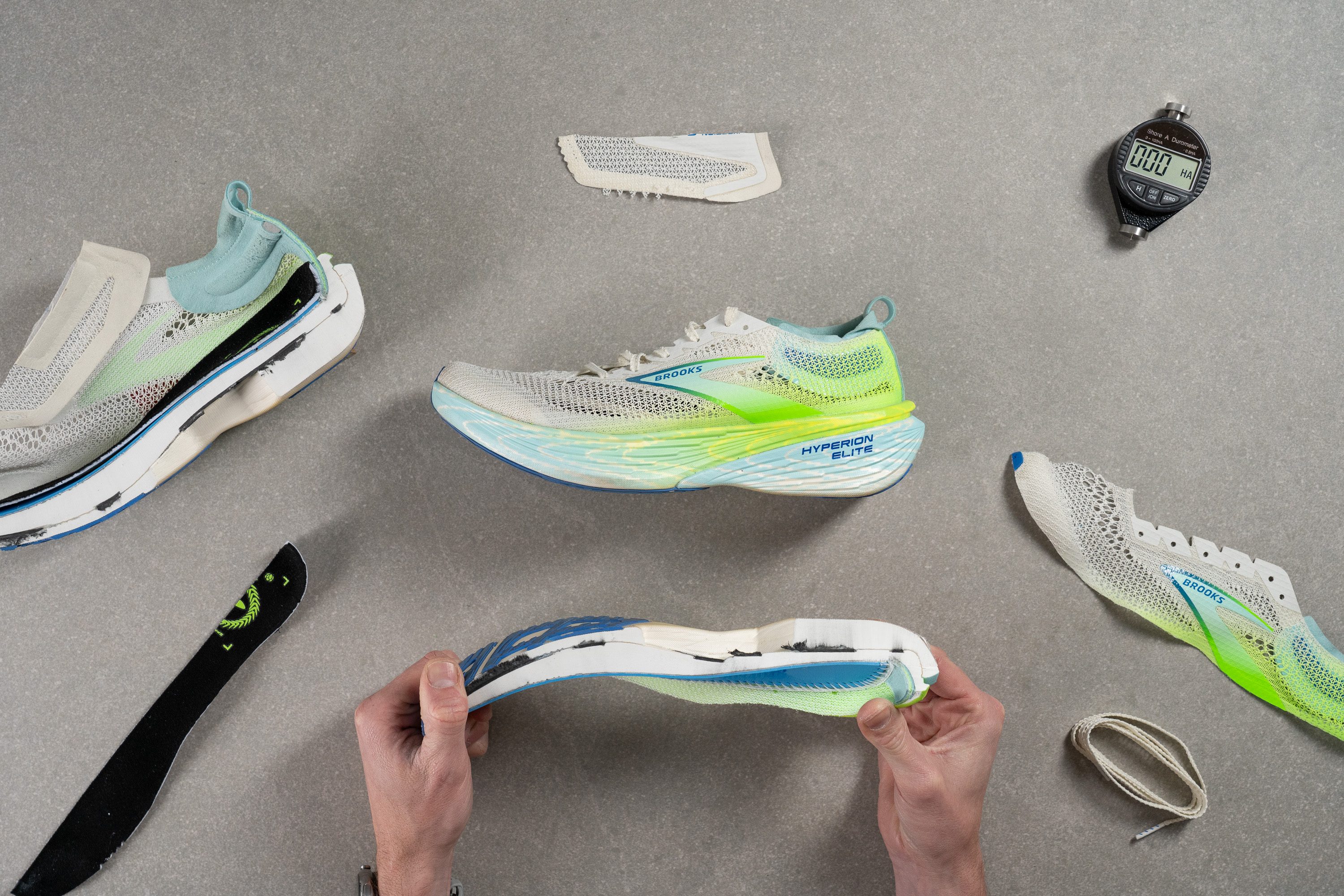
Cushioning
Shock absorption
Shock absorption in the heel is off the charts at 148 SA, while the forefoot sits at a much more moderate 102 SA. That means if you're chasing maximum joint protection, landing heel-first is practically a must in this shoe.
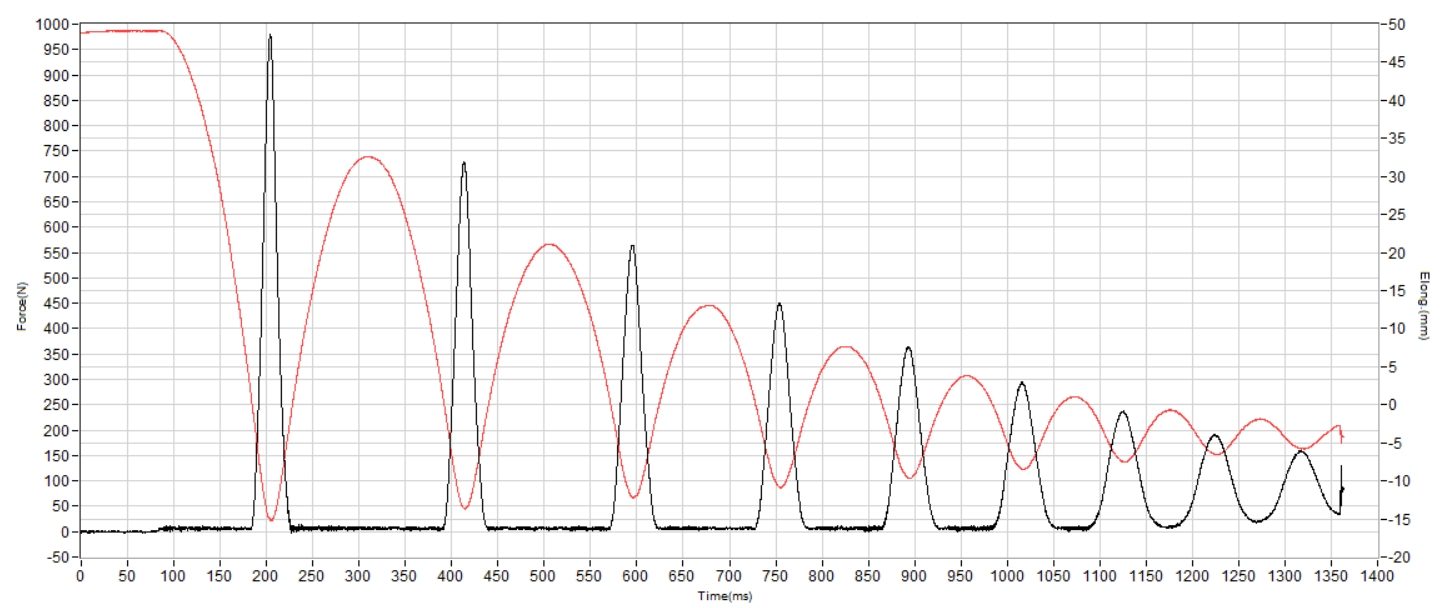
| Hyperion Elite 4 PB | 148 SA |
| Average | 129 SA |
Energy return
Looks like Brooks finally solved the problem with the Elite 4—and PEBA stepped in at the right time. We measured 67.1% energy return in the heel and 71.8% in the forefoot, enough to secure its place among true supershoes. And now Brooks athletes can toe the line without second thoughts...
| Hyperion Elite 4 PB | 67.1% |
| Average | 58.5% |
Heel stack
Brooks kept the same design and upgraded the midsole with a PEBA-based compound, so it wasn’t surprising that the stack height stayed almost identical to its less-exciting sibling at 38.5 mm.
Hence, it sits just below the 40-mm World Athletics limit, maximising heel cushioning for those long, punishing marathons.
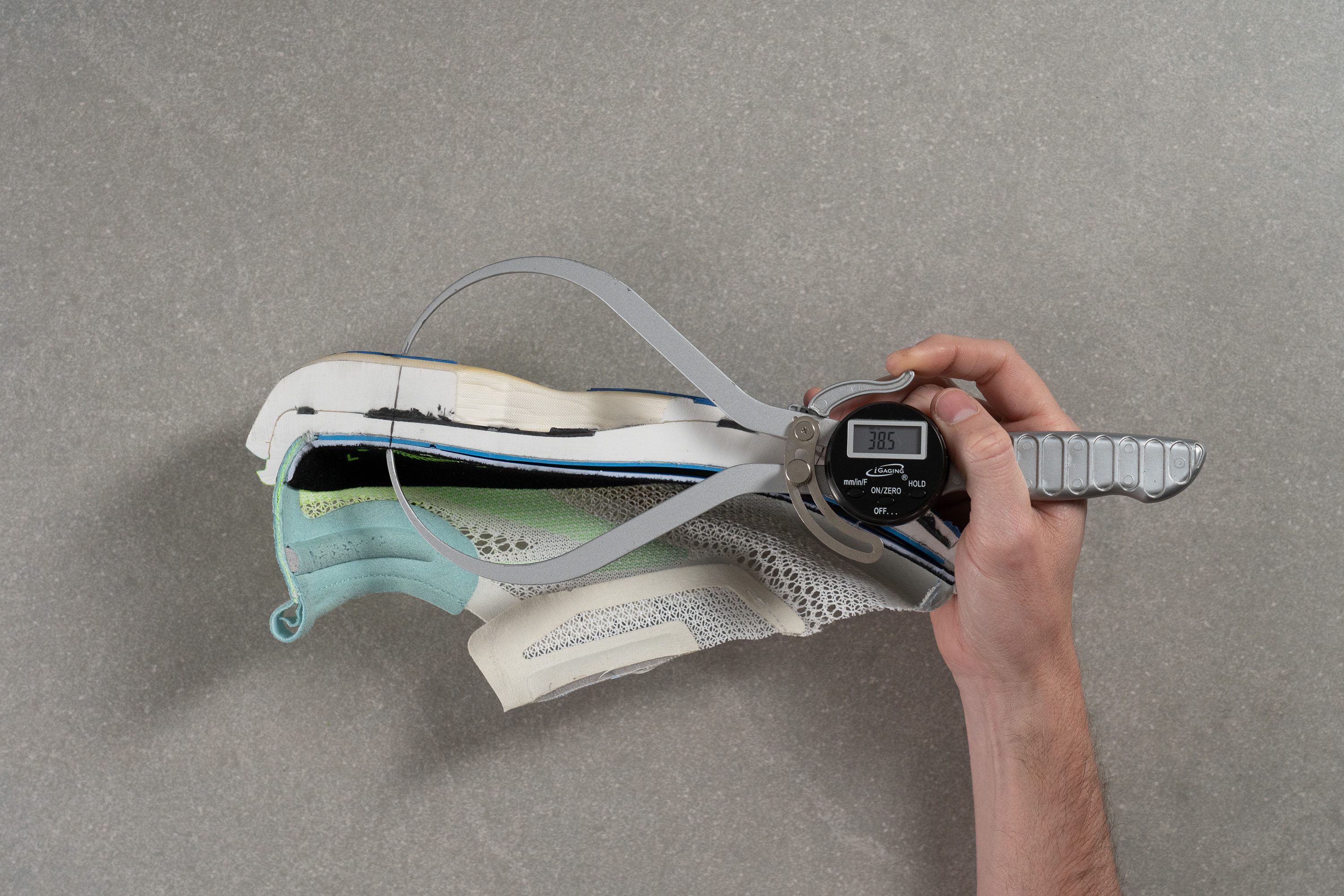
| Hyperion Elite 4 PB | 38.5 mm |
| Average | 34.8 mm |
Forefoot stack
The forefoot measured noticeably thinner than the heel at just 26.8 mm, making this shoe a worse pick for midfoot and forefoot strikers who typically prefer more cushioning up front.
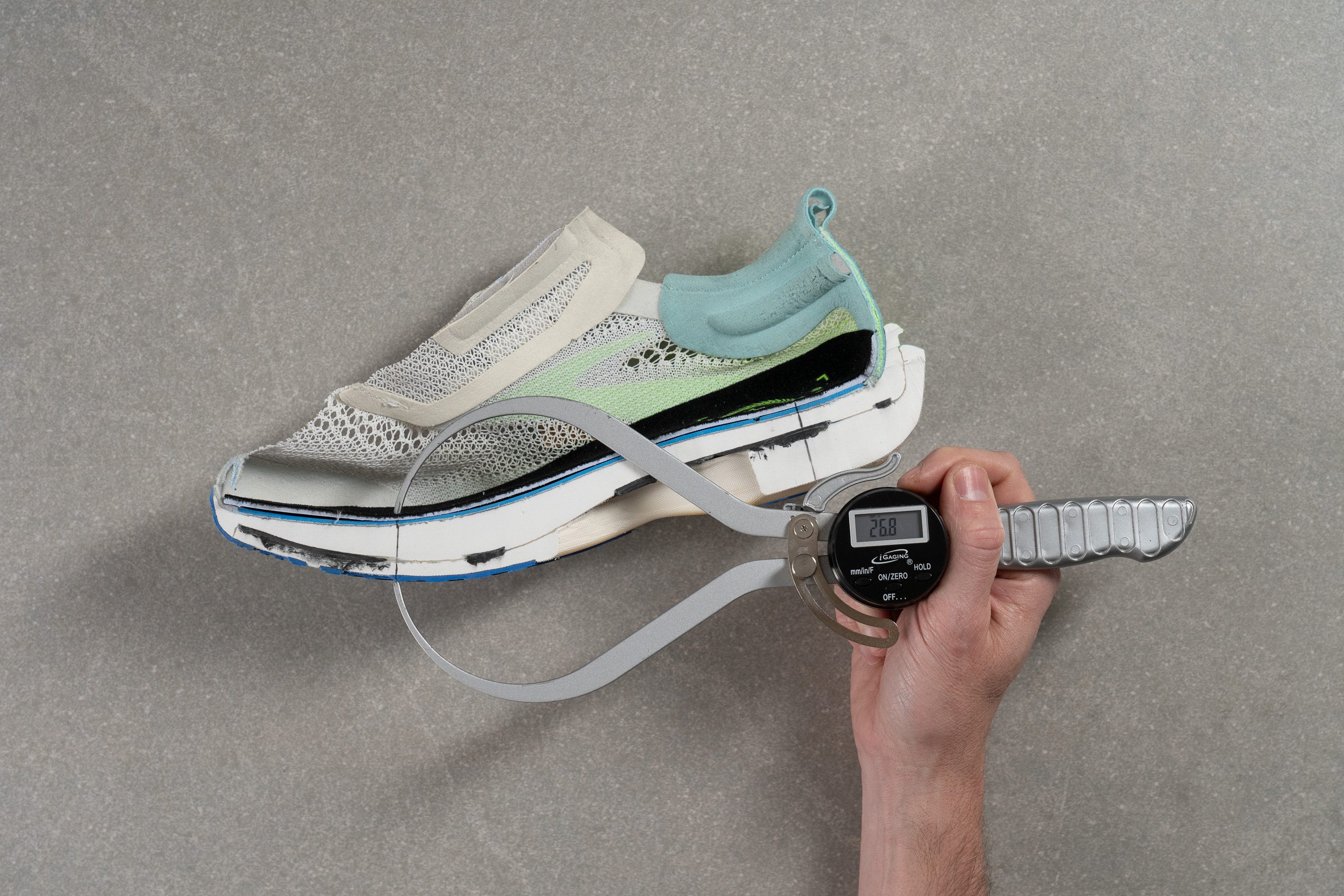
| Hyperion Elite 4 PB | 26.8 mm |
| Average | 26.2 mm |
Drop
The previous two measurements leave us with a drop of 11.7 mm, which didn’t surprise us at all—once again, it’s almost identical to the non-PEBA sibling.
Given its high drop, we’re convinced that this shoe is best suited only for heel strikers or those who genuinely prefer a high-offset design. Otherwise, it feels simply too steep and lacks the lively forefoot punch that midfoot or forefoot runners usually seek.
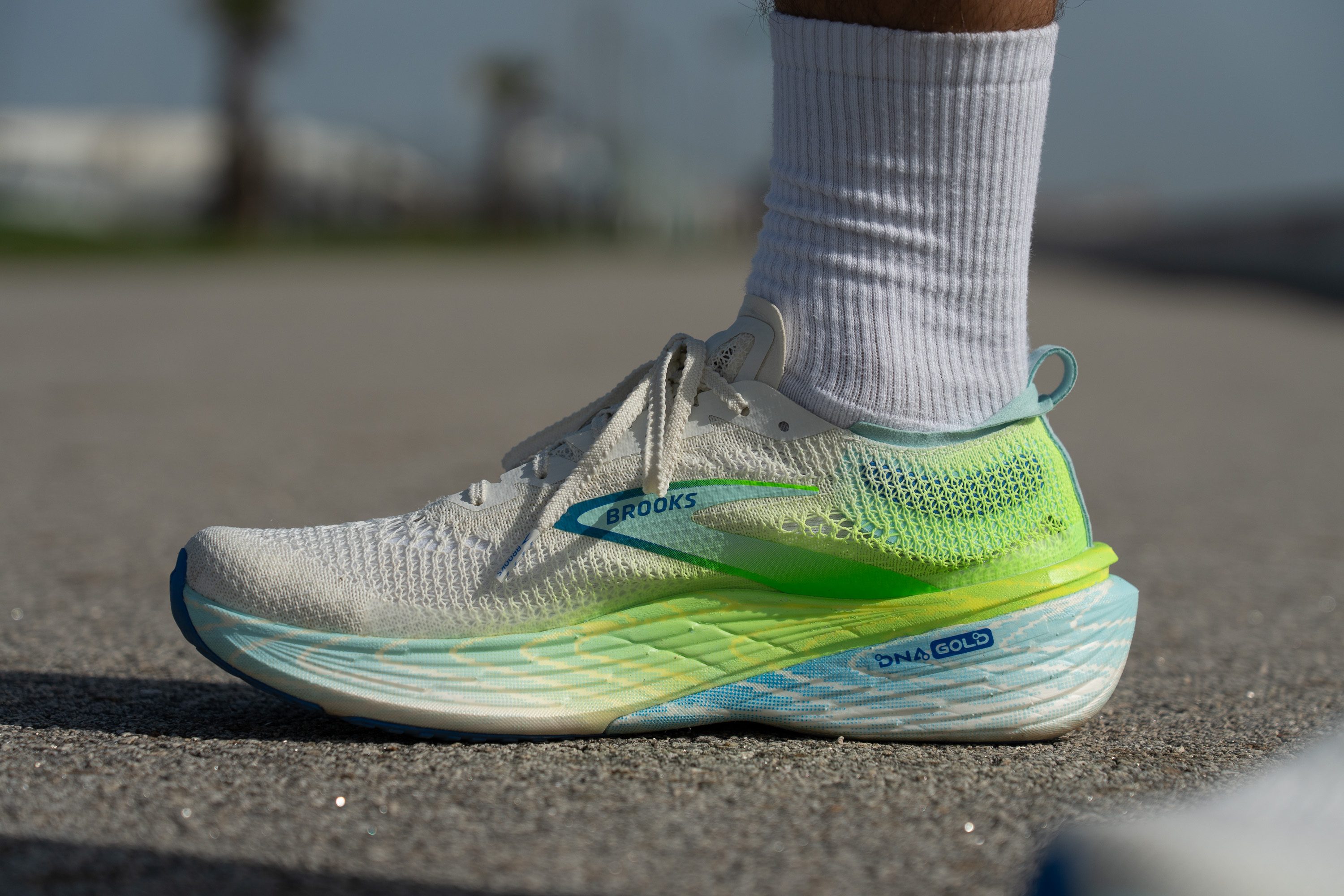
| Hyperion Elite 4 PB | 11.7 mm |
| Average | 8.6 mm |
Midsole softness
The most exciting part of the Brooks Hyperion Elite 4 PB is clearly the midsole. After four editions where everyone was expecting a PEBA foam and Brooks kept delivering less energetic materials, we are thrilled to report that they finally did it. Better late than never...
The all-new DNA Gold midsole arrived fashionably-late but delivered in full. It's a fast, highly-responsive compound that we found very close to ZoomX or FF Turbo+ when it comes to bounce and speed, and it's a true superfoam.
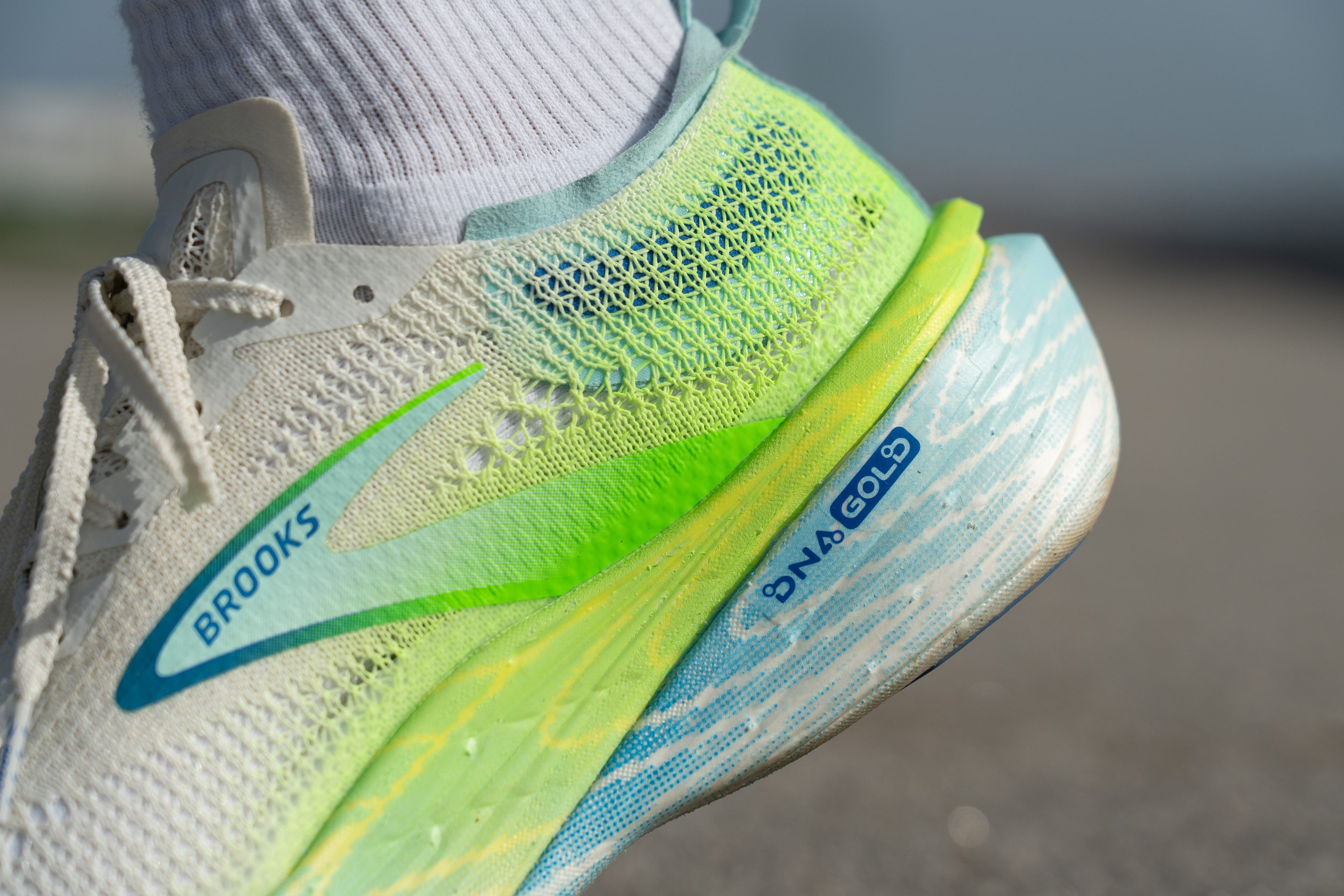
In terms of softness, it feels nicely-balanced at 19.5 HA, which is especially good for heel strikers. In our tests, we discovered that it prevents sinking in too much, allowing a buttery-smooth roll forward that keeps the ride lively and controlled.

| Hyperion Elite 4 PB | 19.5 HA |
| Average | 20.4 HA |
Secondary foam softness
The Hyperion Elite 4 PB sticks with the classic, endlessly-copied midsole design first seen in the original Vaporfly, with two slabs of foam and a carbon plate sandwiched between them.
Naturally, we also measured the softness of the secondary foam. At 19.5 HA, it matches the main layer exactly, confirming that Brooks chose a single-density PEBA setup without tweaking the feel between the two layers.
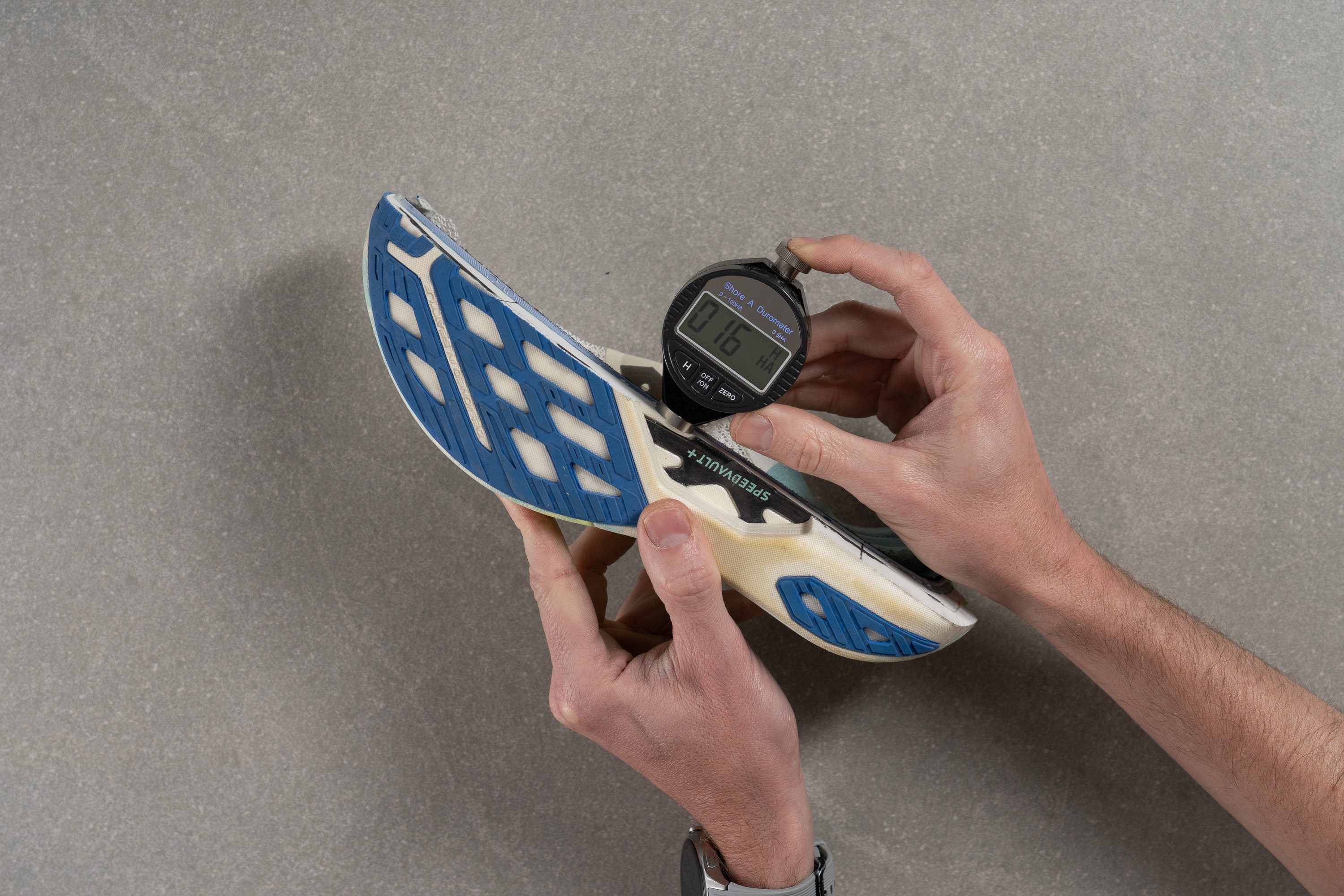
| Hyperion Elite 4 PB | 19.5 HA |
| Average | 22.7 HA |
Rocker
Brooks took the supershoe playbook to design the rocker of this shoe.
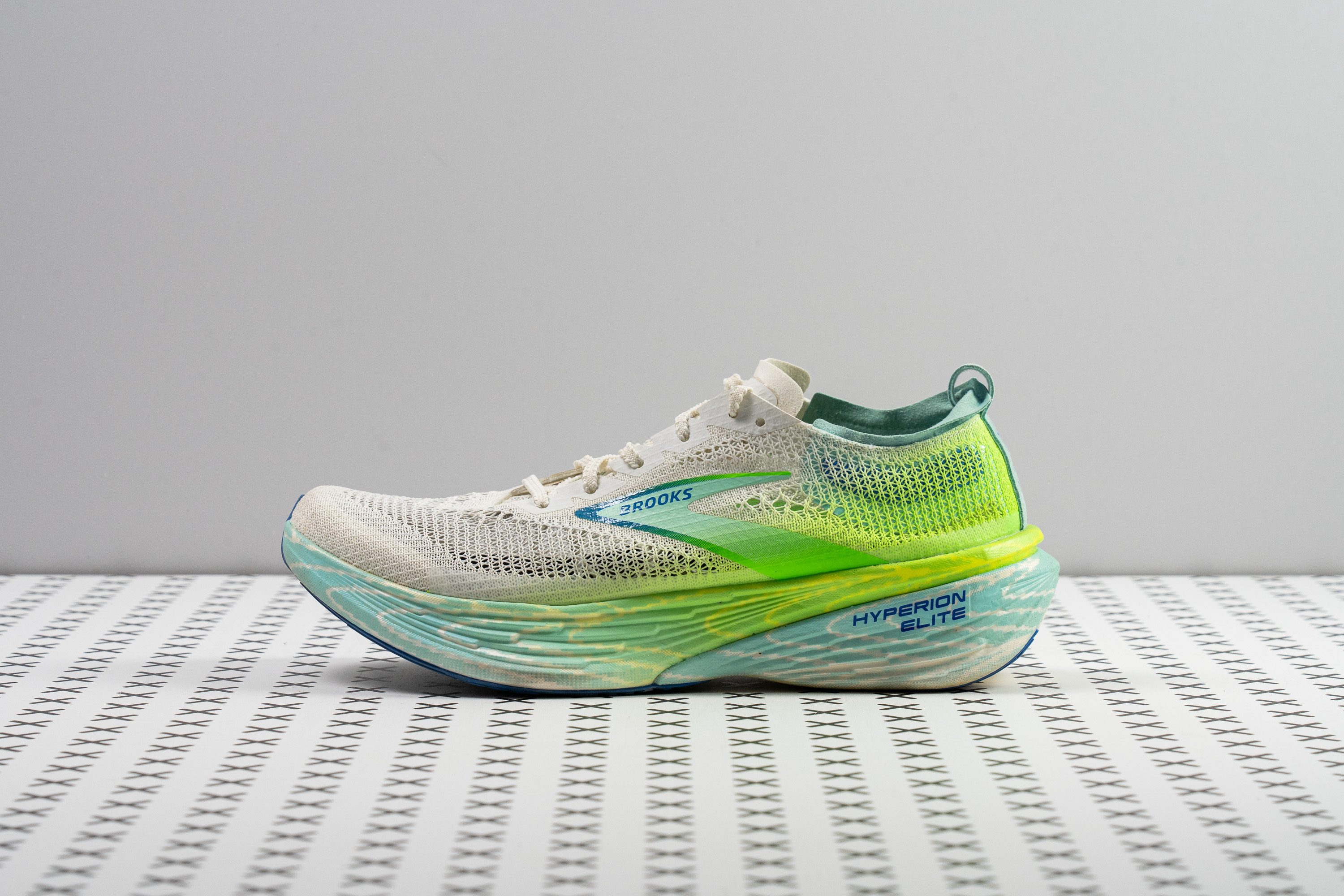
We found that the rocker in this shoe helps to bend the shoe and overcome the stiffness of the plate in a powerful way, boosting toe-off without feeling too forced. We also discovered that the heel has a sharp-edged curvature that makes sense for heel strikers.
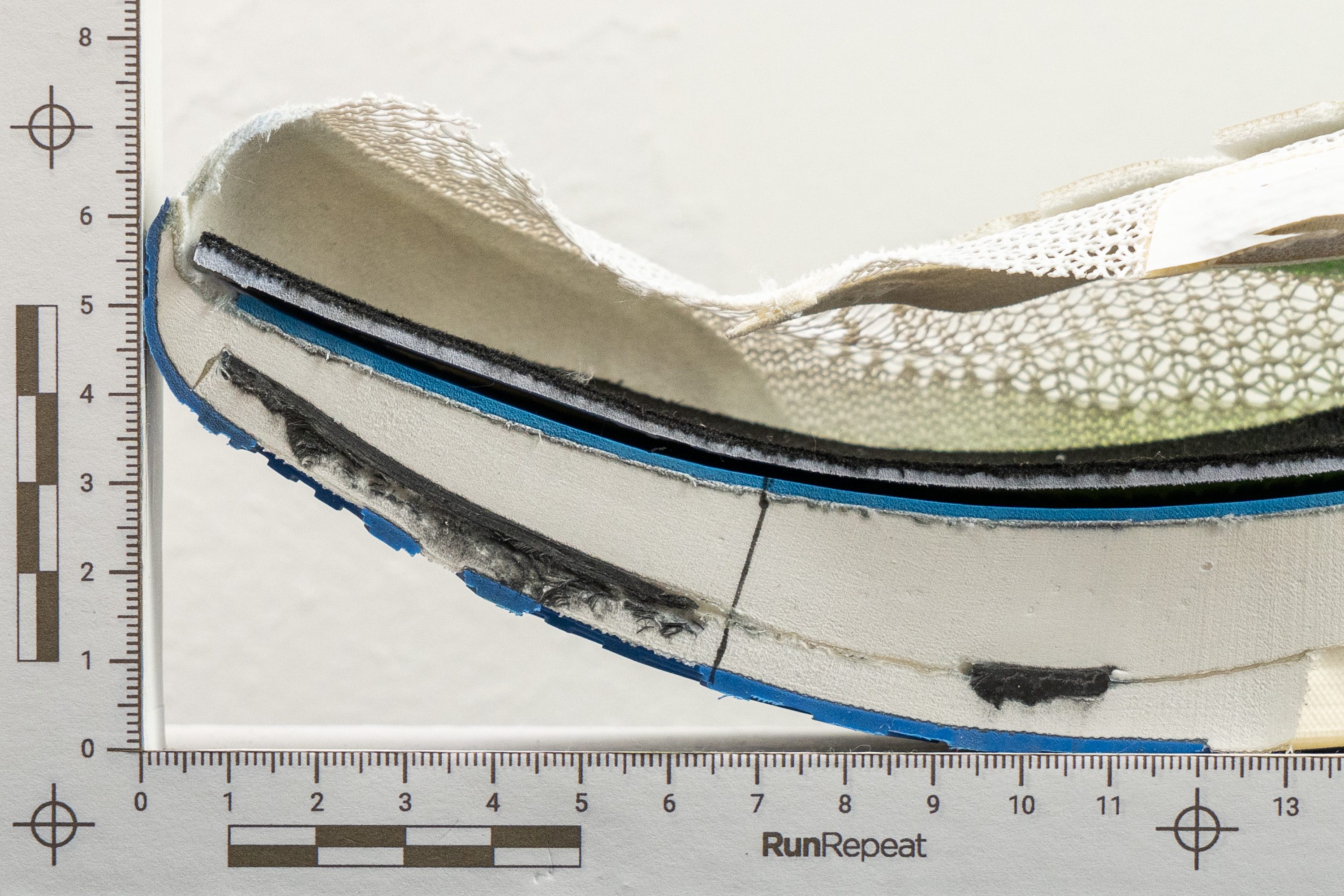
Plate
We found the Speedvault+ carbon plate to be a bold move from Brooks that truly stands apart—credit to them for trying something refreshingly different from everyone else!
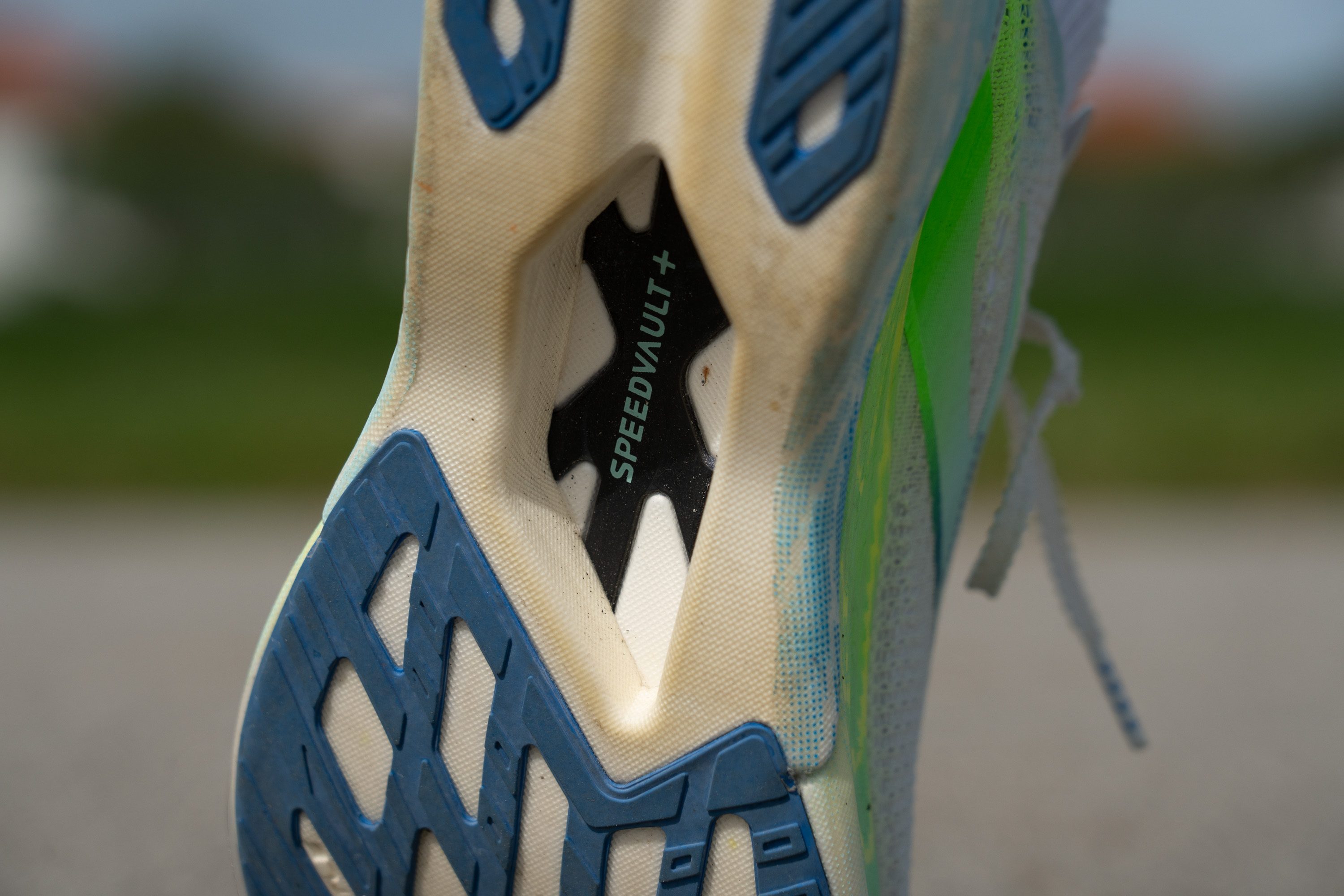
The idea behind these smartly-crafted cutouts is to deliver a feather-light yet ultra-rigid plate that blends stiffness and weight reduction. And we saw that the exposed section through the midsole cutout is no accident...
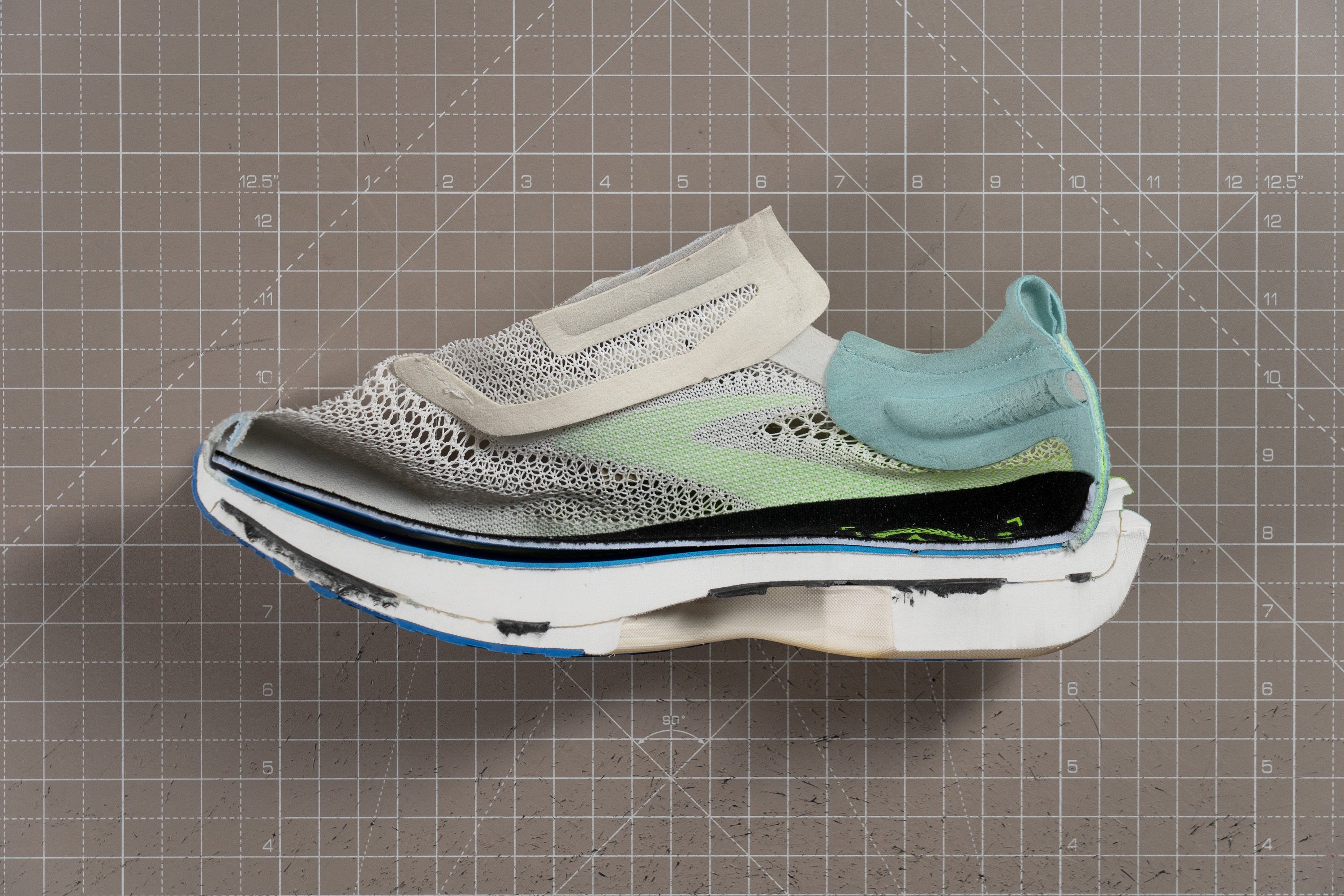
Size and fit
Size
Brooks Hyperion Elite 4 PB fits true to size (14 votes).
Width / Fit
Brooks usually delivers narrow-and-snug fits in its racing shoes, and the Hyperion Elite 4 PB gave us that compact feeling right away. Still, we don’t rely just on feel—we always get real measurements, so we got ready to create a nice jelly.
After the gel had settled, we measured the width of the Hyperion Elite 4 PB and got 91.3 mm on our calliper. This race-driven measurement confirmed what we suspected during testing: this is a really narrow, speed-focused design.
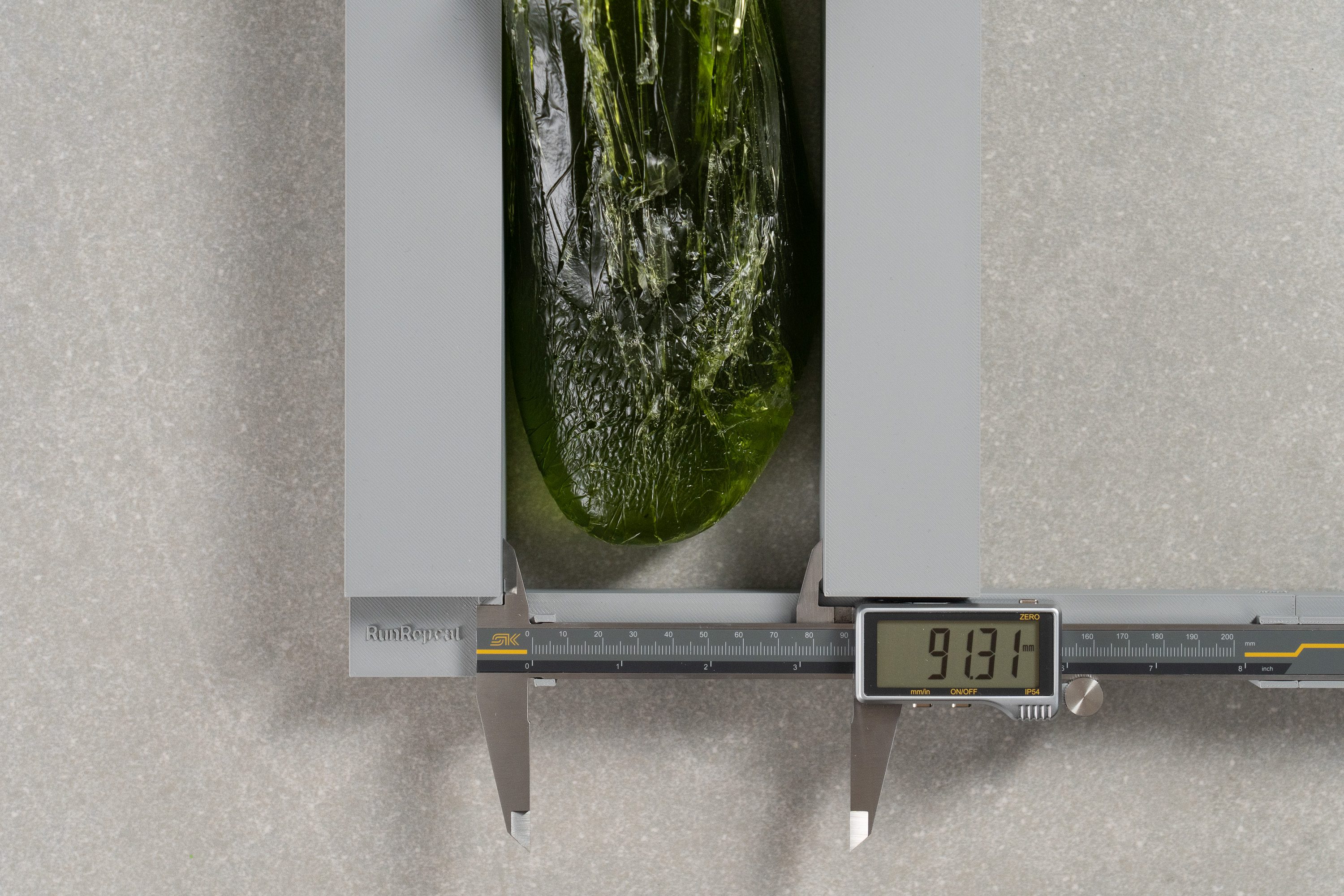
| Hyperion Elite 4 PB | 91.3 mm |
| Average | 95.1 mm |
Toebox width
The big toe area revealed a sharp-and-narrow taper at 71.0 mm, limiting natural toe splay. In our view, this clearly suggests that the Hyperion Elite 4 PB is not designed for runners with broad, wide feet.
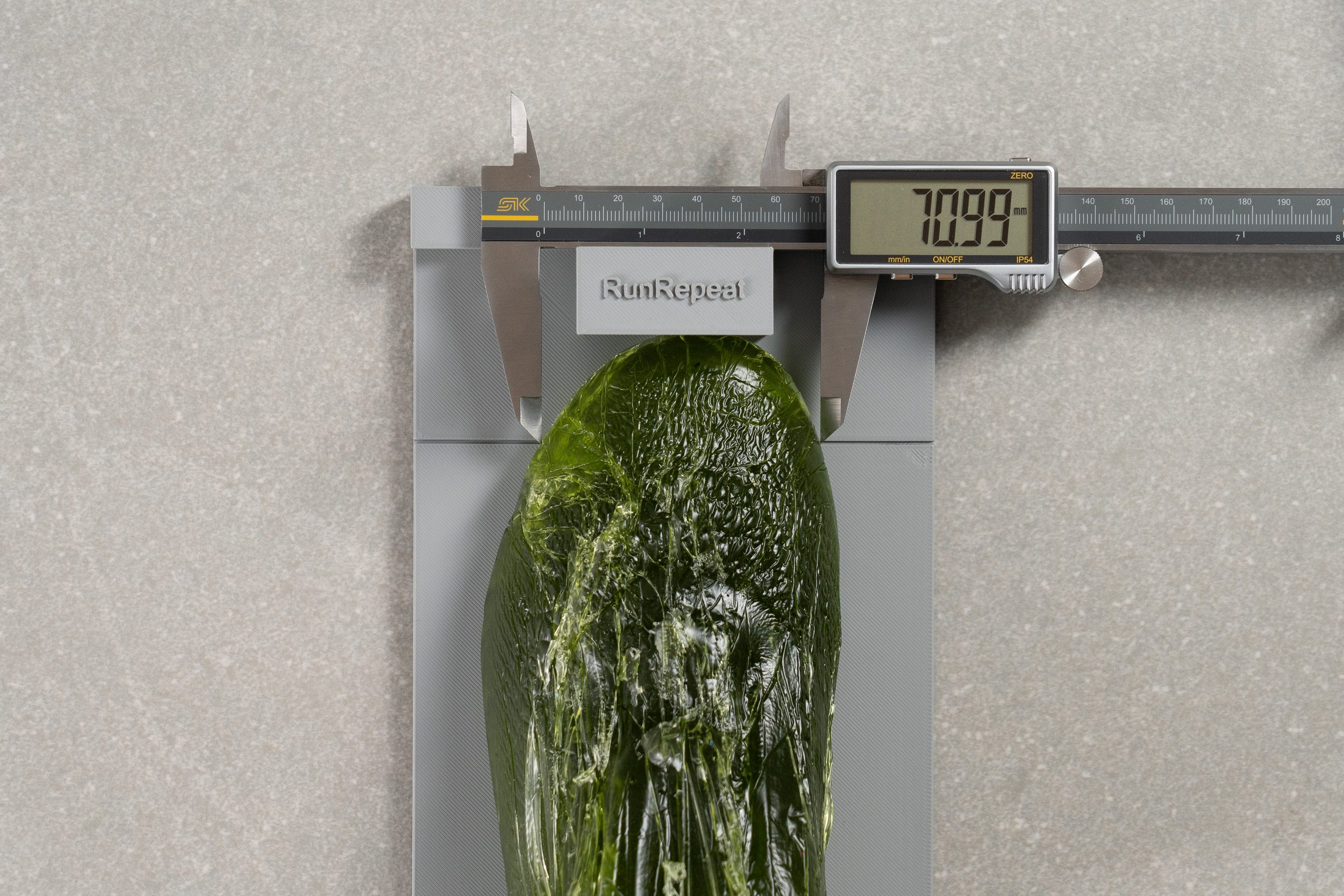
| Hyperion Elite 4 PB | 71.0 mm |
| Average | 73.3 mm |
Toebox height
In terms of vertical height, we measured 26.4 mm of space for the toes.
It falls slightly below average, offering enough room to prevent toe crushing while still delivering a confident lockdown that we really appreciated.
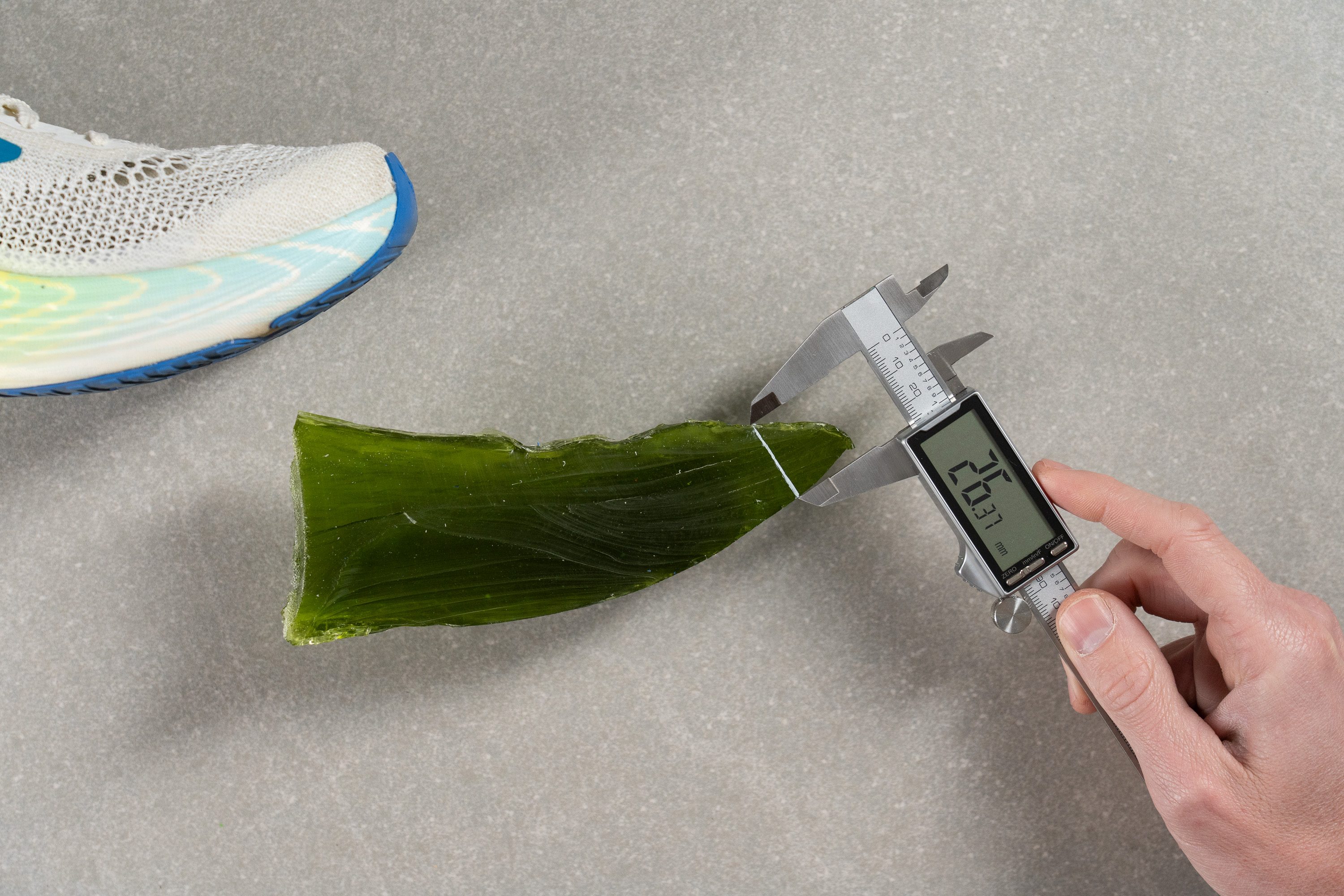
| Hyperion Elite 4 PB | 26.4 mm |
| Average | 27.1 mm |
Traction / Grip
Traction test
Choosing a softer rubber blend for the outsole not only helped to save grammes in the Hyperion Elite 4 PB but also gave it better traction.
Following the SATRA TM144 grip test method, we recorded a solid friction score of 0.55 in this Brooks shoe. This is an even better result than in the original Hyperion Elite 4 (0.50) helping the PB version grip the ground exceptionally well, even in those sharper turns.
| Hyperion Elite 4 PB | 0.55 |
| Average | 0.48 |
Outsole design
The outsole of the Hyperion Elite 4 PB is identical to its non-PEBA sibling, combining strategically-placed rubber with exposed foam to reduce weight.
The forefoot includes wide, grippy segments for solid traction during toe-off, while the heel uses compact pods for targeted durability. A midfoot cutout exposes the SpeedVault plate, adding a sleek touch.
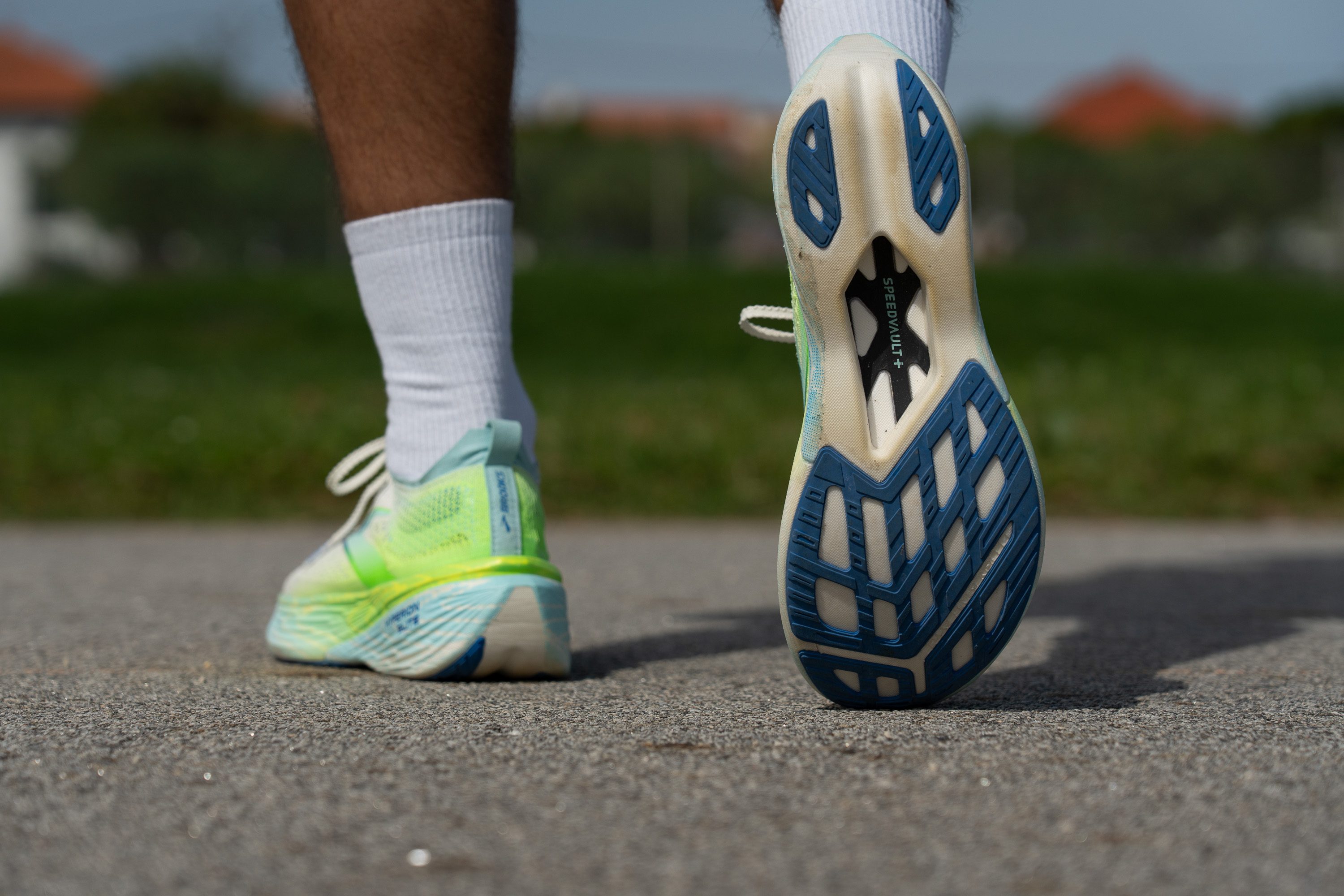
Flexibility / Stiffness
The carbon plate Brooks picked for this shoe is extremely stiff both torsionally—as we already showed—and longitudinally, as this test confirms with a result of 24.0N. Sure, it delivers a nice boost but may feel too harsh for runners sensitive to ultra-stiff setups or dealing with issues like Morton’s neuroma.
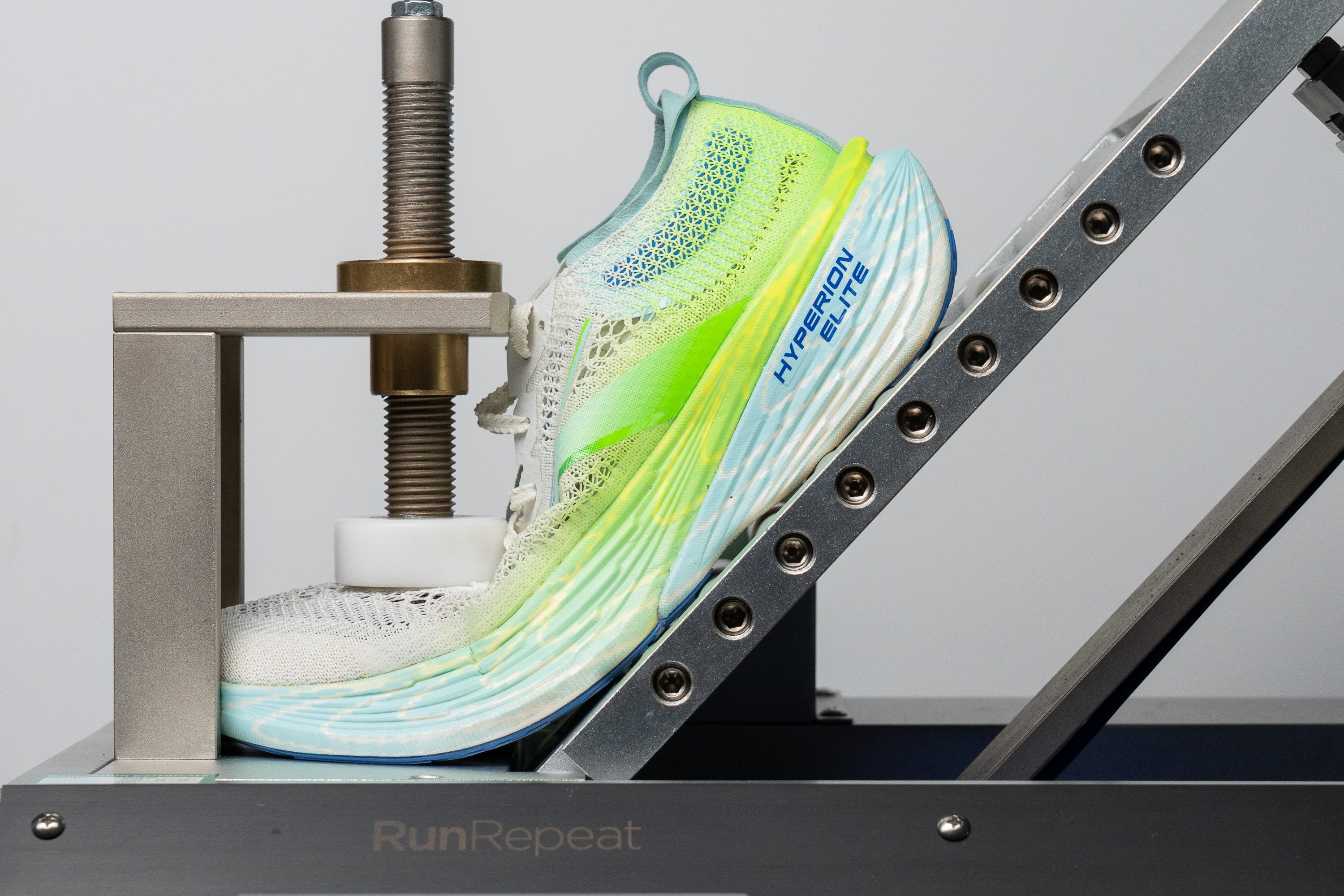
| Hyperion Elite 4 PB | 24.0N |
| Average | 15.3N |
Weight
The biggest win of switching the Hyperion Elite 4 to PEBA foam is the energy return increase—but the weight drop also stands out. It's now 12% lighter than before, which is a major step forward.
Still, at 197g or 6.95 oz, it doesn’t land in the feather-light supershoe category. With brands like Nike pushing weight limits with options like the Streakfly 2, we think Brooks still has lots of room for improvement.
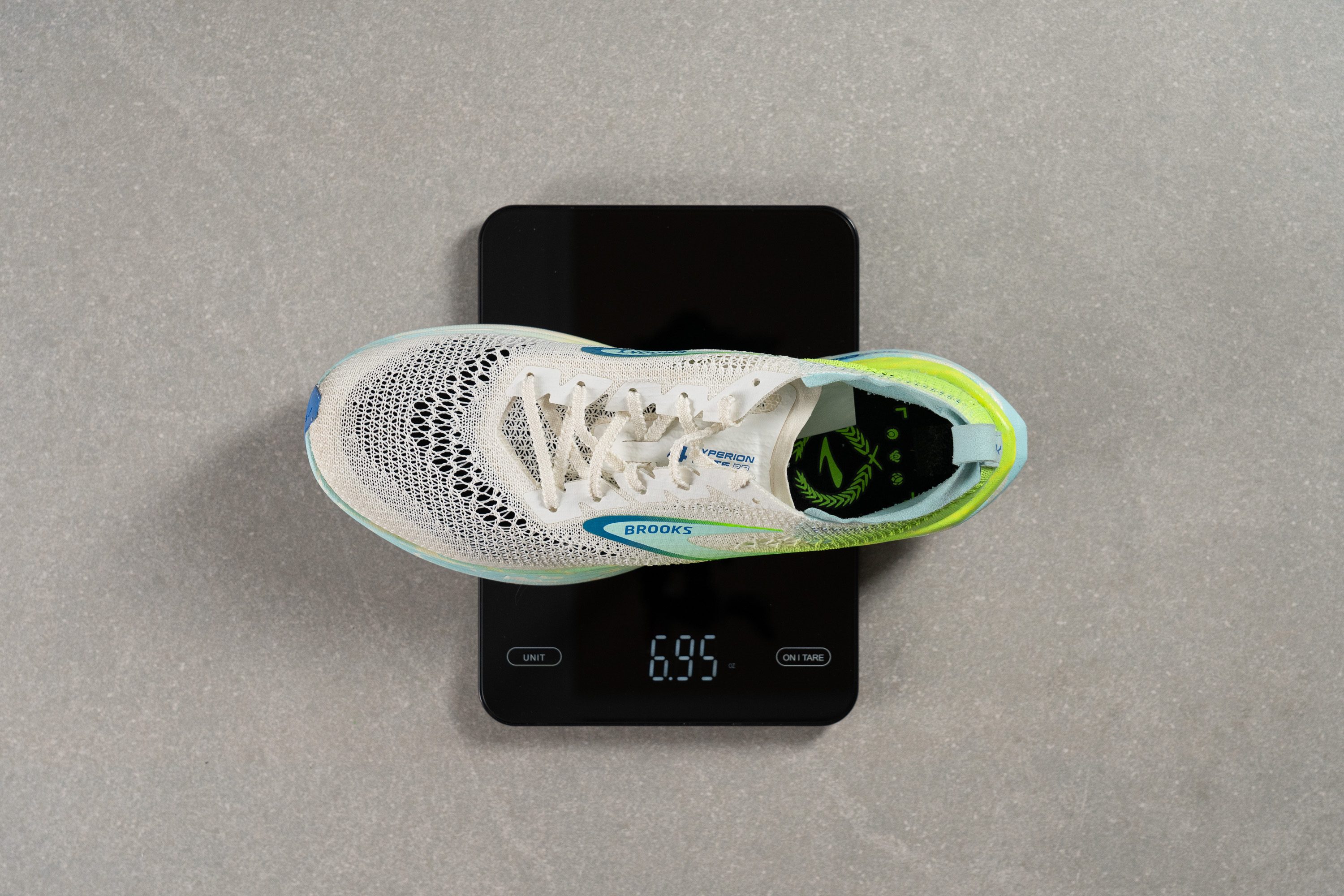
| Hyperion Elite 4 PB | 6.9 oz (197g) |
| Average | 9.3 oz (264g) |
Breathability
We were genuinely impressed with the upper of the Brooks Hyperion Elite 4, and we're incredibly happy to find that Brooks kept the same ultra-breathable mesh in the PB version of that model. That's good news, because it's excellent.
Look at our smoke test—it just gets out without any kind of interruption. Thanks to the oversized ventilation holes of the toebox (which vary in size depending on the position), this shoe is perfect for gruelling summer workouts or races.
Ventilation is basically present throughout the whole shoe, although the midfoot and forefoot areas are the most airy ones, as expected.

Eager to see it as close as possible, we turned on the microscope and found that this upper is as minimal as it gets. Basically, we think it's impossible to make it thinner!
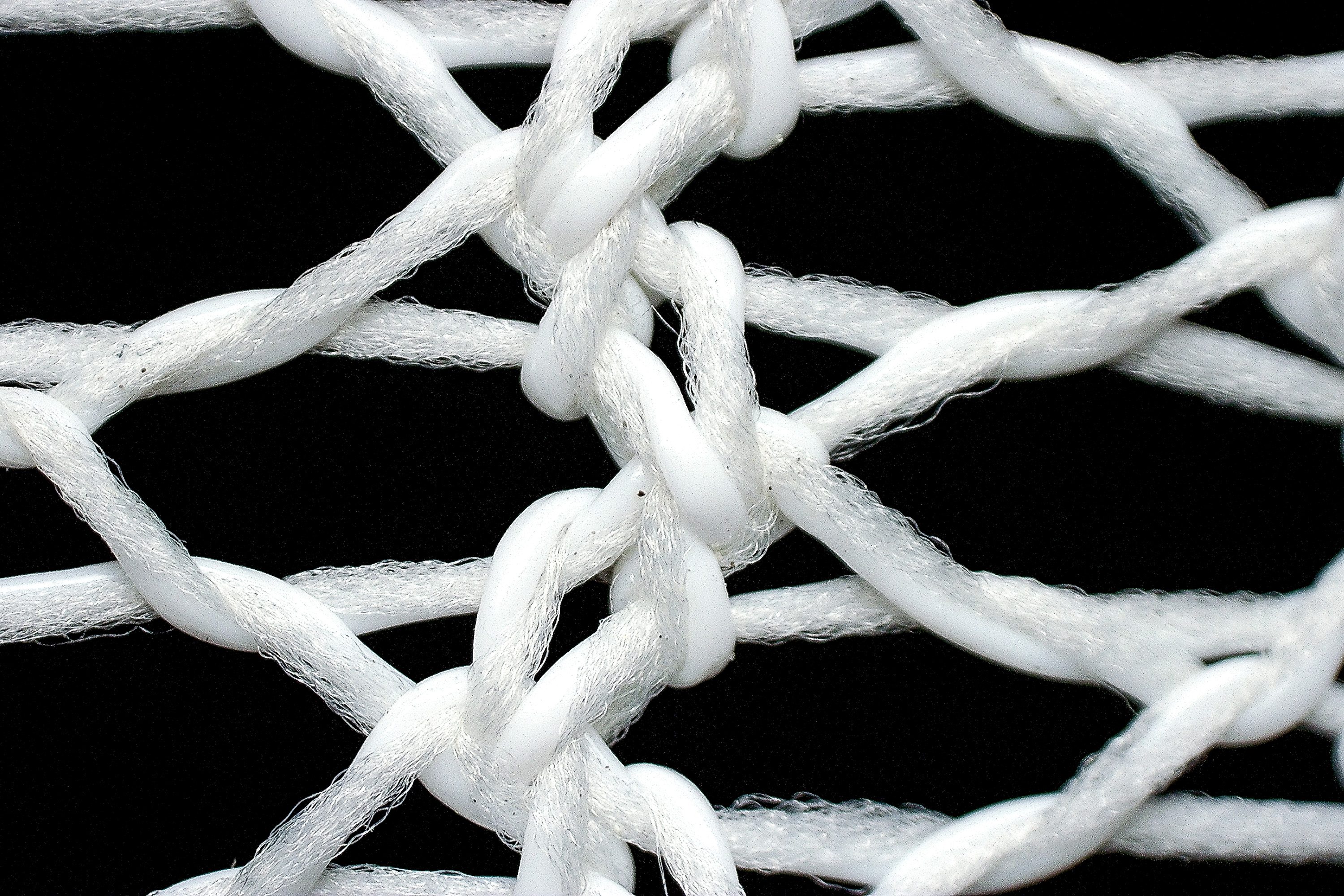
Forget about finding multiple layers or tonnes of padding. While the tongue is a bit comfier than other supershoes, it's still a low-weight design from heel to toe.
| Hyperion Elite 4 PB | 5 |
| Average | 3.7 |
Stability
Lateral stability test
Brooks went with a go-fast, narrow design where stability clearly takes the back seat—especially in the heel. Despite the high drop, we found it potentially unstable for many rearfoot strikers, with only the midfoot sidewalls offering a touch of support.
But that’s pretty much expected. The Hyperion Elite 4 PB delivers the fun ride that many runners actually look for in a supershoe. It’s not built for structure—it’s built to chase PBs. If you want a more stable option, we think the Nike Alphafly 3 and its ultra-wide platform are a better match.
Torsional rigidity
The Speedvault+ plate in the Hyperion Elite 4 PB may feature eye-catching cutouts and a unique shape, but none of that takes away from its ultra-rigid structure. That’s why we rated torsional rigidity at 5/5.
| Hyperion Elite 4 PB | 5 |
| Average | 3.5 |
Heel counter stiffness
The heel counter provides only minimal support—just enough for a 2/5 in our test. This approach is becoming a familiar pattern across most modern supershoes...
| Hyperion Elite 4 PB | 2 |
| Average | 2.9 |
Midsole width - forefoot
One of the first things we noticed in the Hyperion Elite 4 PB is its nimble-and-responsive ride—perfect for short races filled with sharp turns. It feels ultra-quick on foot.
We measured the widest part of the forefoot at just 111.0 mm, which sits noticeably below the average running shoe.

| Hyperion Elite 4 PB | 111.0 mm |
| Average | 114.4 mm |
Midsole width - heel
But it’s the heel that truly breaks away from the pack. At only 75.4 mm, you can expect a wild ride!
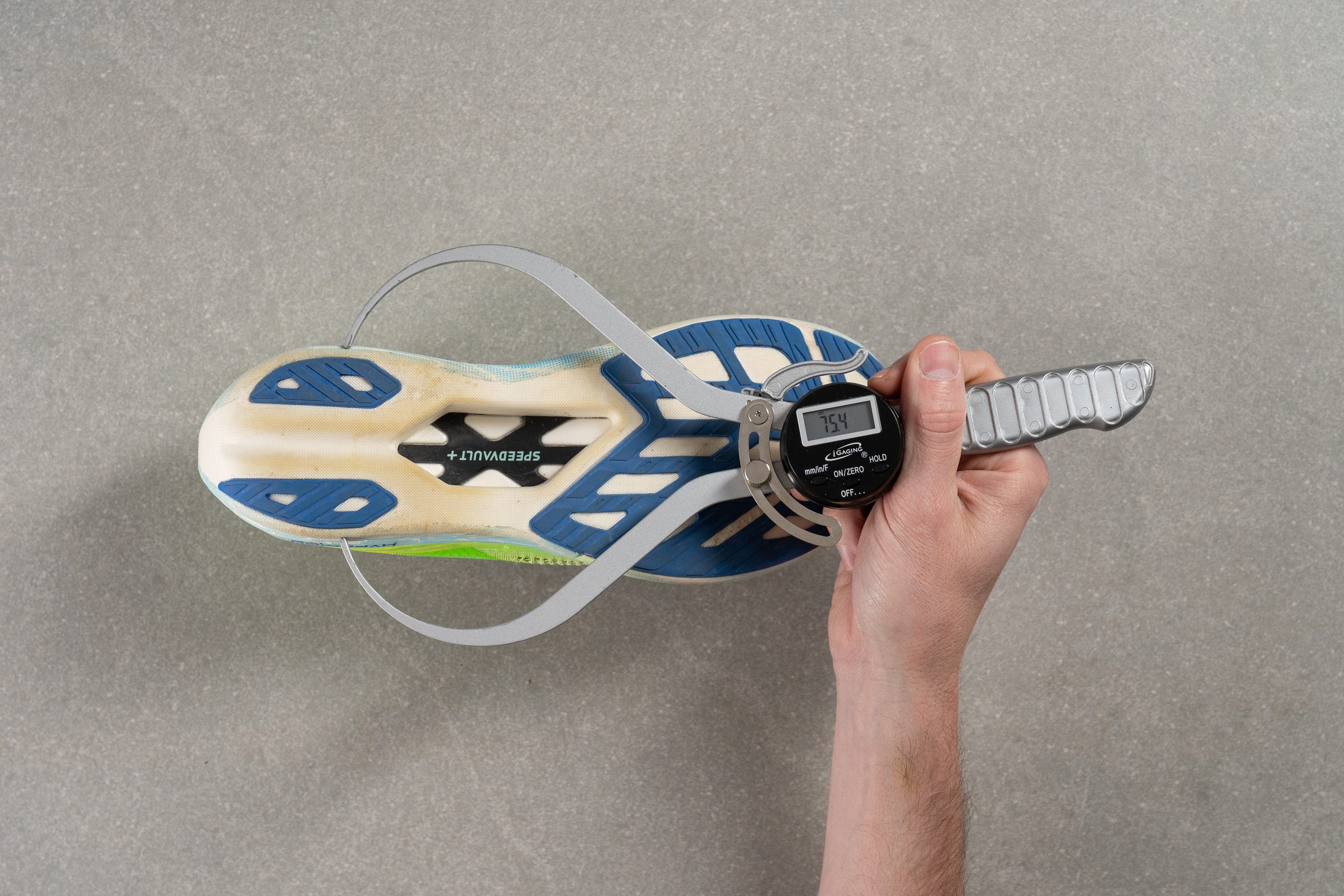
| Hyperion Elite 4 PB | 75.4 mm |
| Average | 90.7 mm |
Durability
Toebox durability
We're used to making a full hole in a millisecond with this type of upper, but the Hyperion Elite 4 PB put on a show against our Dremel and earned a well-deserved 5/5!
| Hyperion Elite 4 PB | 2 |
| Average | 2.6 |
Heel padding durability
The heel padding turned out to be extra-durable as well, grabbing another solid 5/5. If you’re after a race-ready, long-lasting upper in a supershoe, this is a top pick.
| Hyperion Elite 4 PB | 5 |
| Average | 3.4 |
Outsole hardness
After logging two standout scores in durability, we moved the Hyperion Elite 4 PB to perform some tests on the outsole. At the end of the day, this is a crucial component in any supershoe.

To keep weight down, Brooks designed a stripped-back outsole that uses a softer rubber. Our durometer confirmed the latter with an HC reading of 64.0.
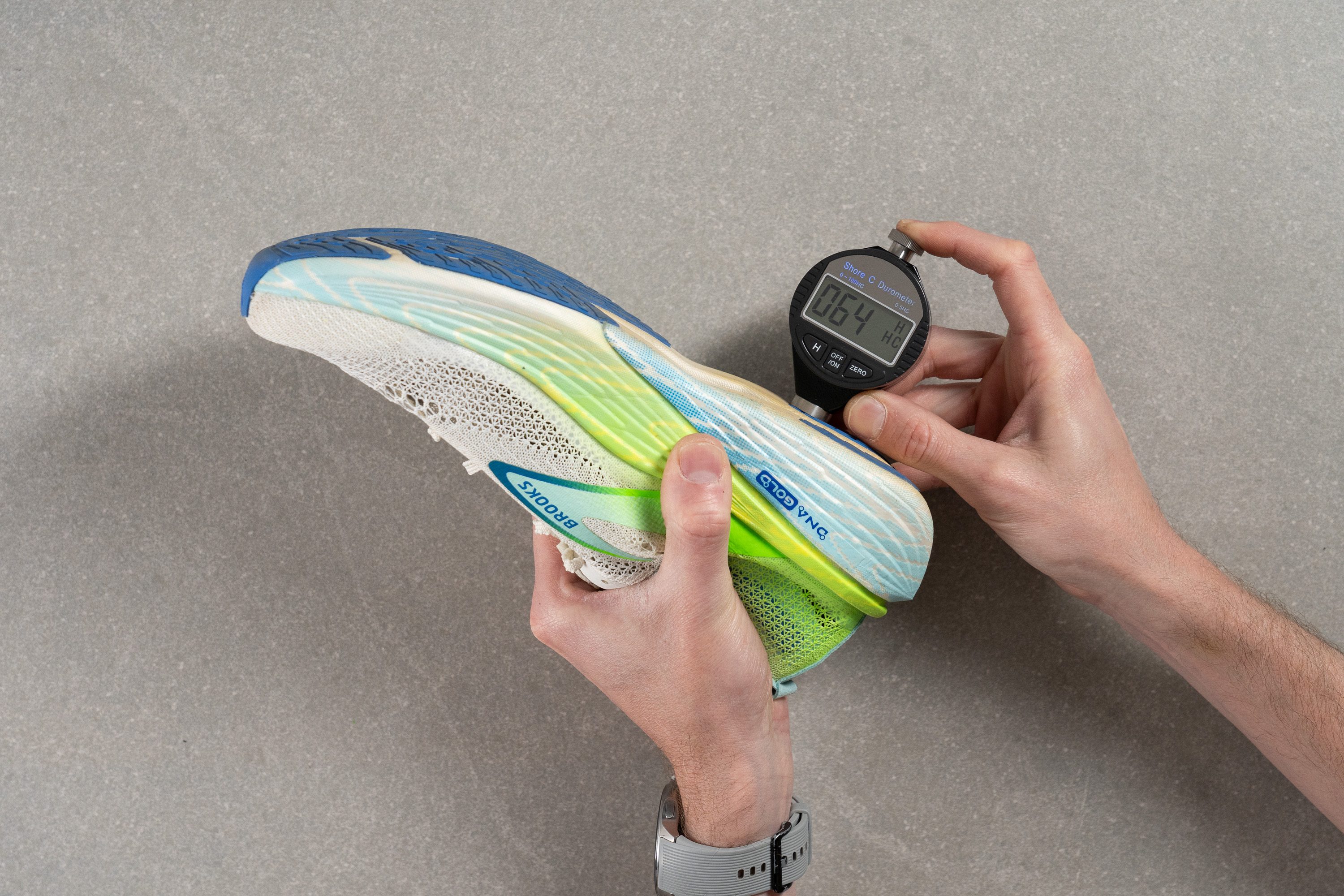
| Hyperion Elite 4 PB | 64.0 HC |
| Average | 79.2 HC |
Outsole durability
Although the rubber was softer than average during our inspection, we were surprised by its good performance in our Dremel test. We found just 1.0 mm of wear—an impressive result for a competition shoe. Therefore, we can confirm that this outsole stands out among supershoes.
| Hyperion Elite 4 PB | 1.0 mm |
| Average | 1.1 mm |
Outsole thickness
In terms of thickness, the outsole surprised us at 2.6 mm. From our perspective, Brooks could shave it down slightly to reduce weight, as it's still a weakness of the Hyperion Elite 4 PB.
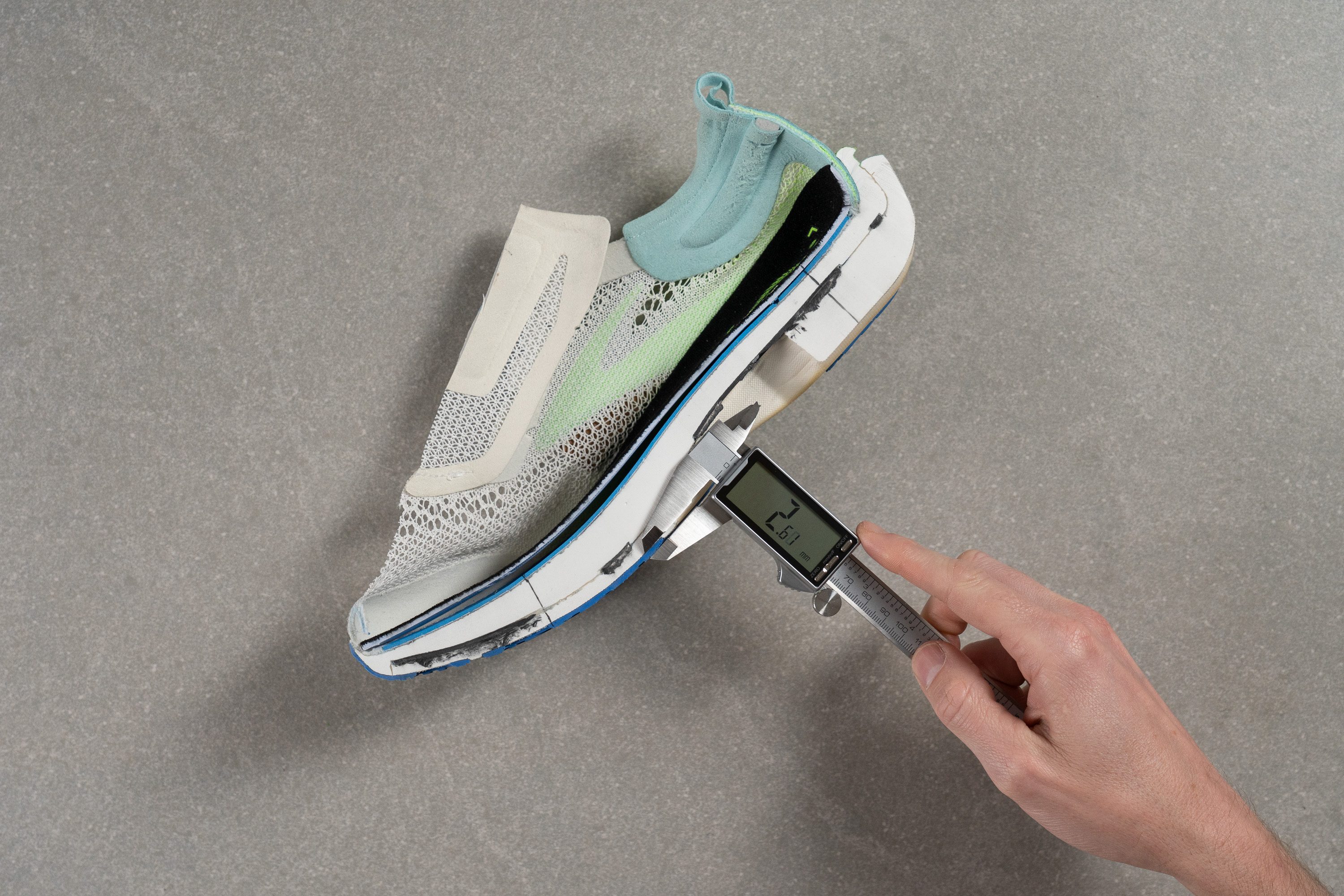
| Hyperion Elite 4 PB | 2.6 mm |
| Average | 3.2 mm |
Misc
Insole thickness
The insole is paper-thin at just 2.3 mm, and we’re all for it—more room for that energy-packed PEBA foam!
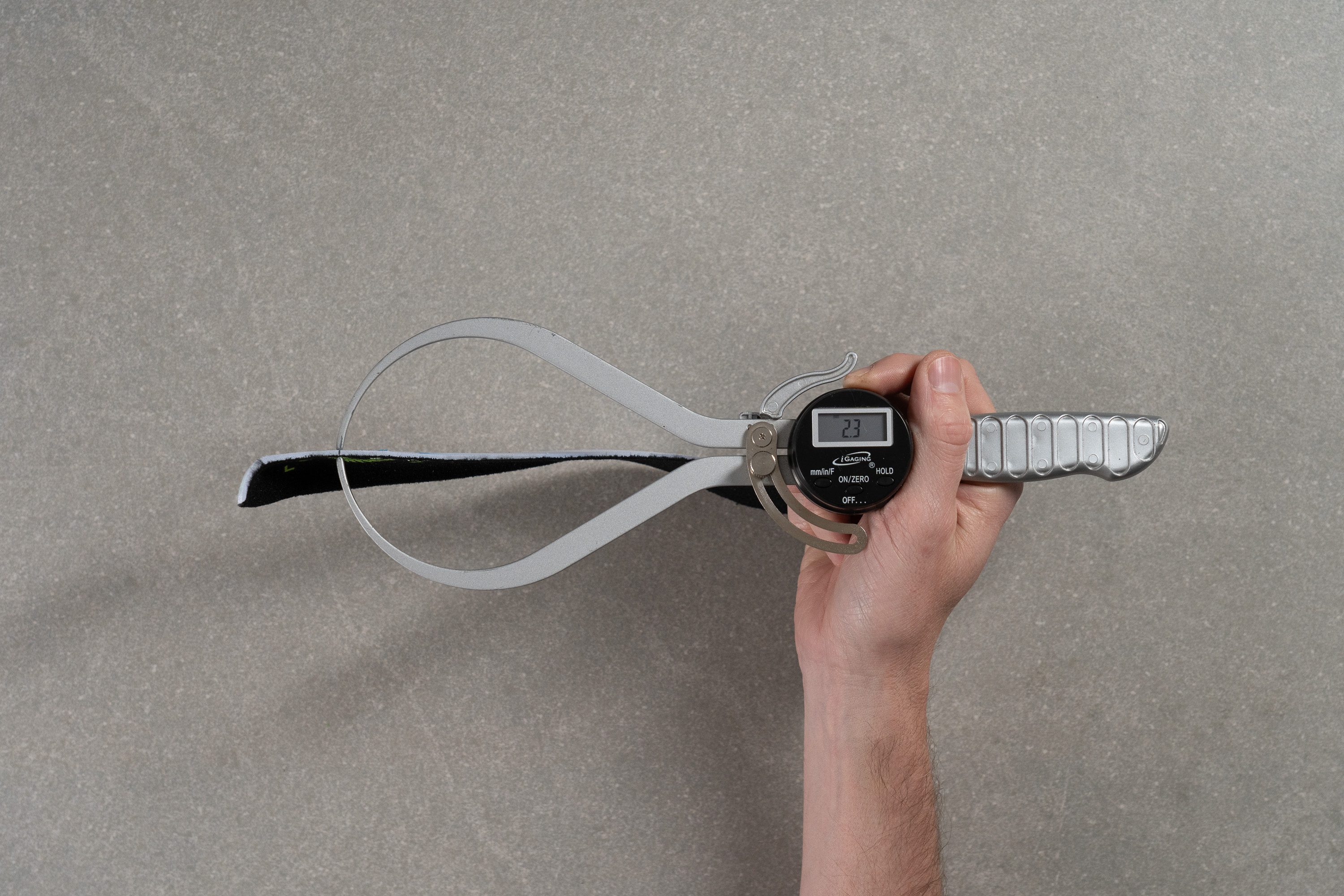
| Hyperion Elite 4 PB | 2.3 mm |
| Average | 4.5 mm |
Removable insole
The insole is removable, giving you the option to swap it out. However, since the stock insole is ultra-thin, most aftermarket replacements could make the toebox feel overly cramped and uncomfortable.
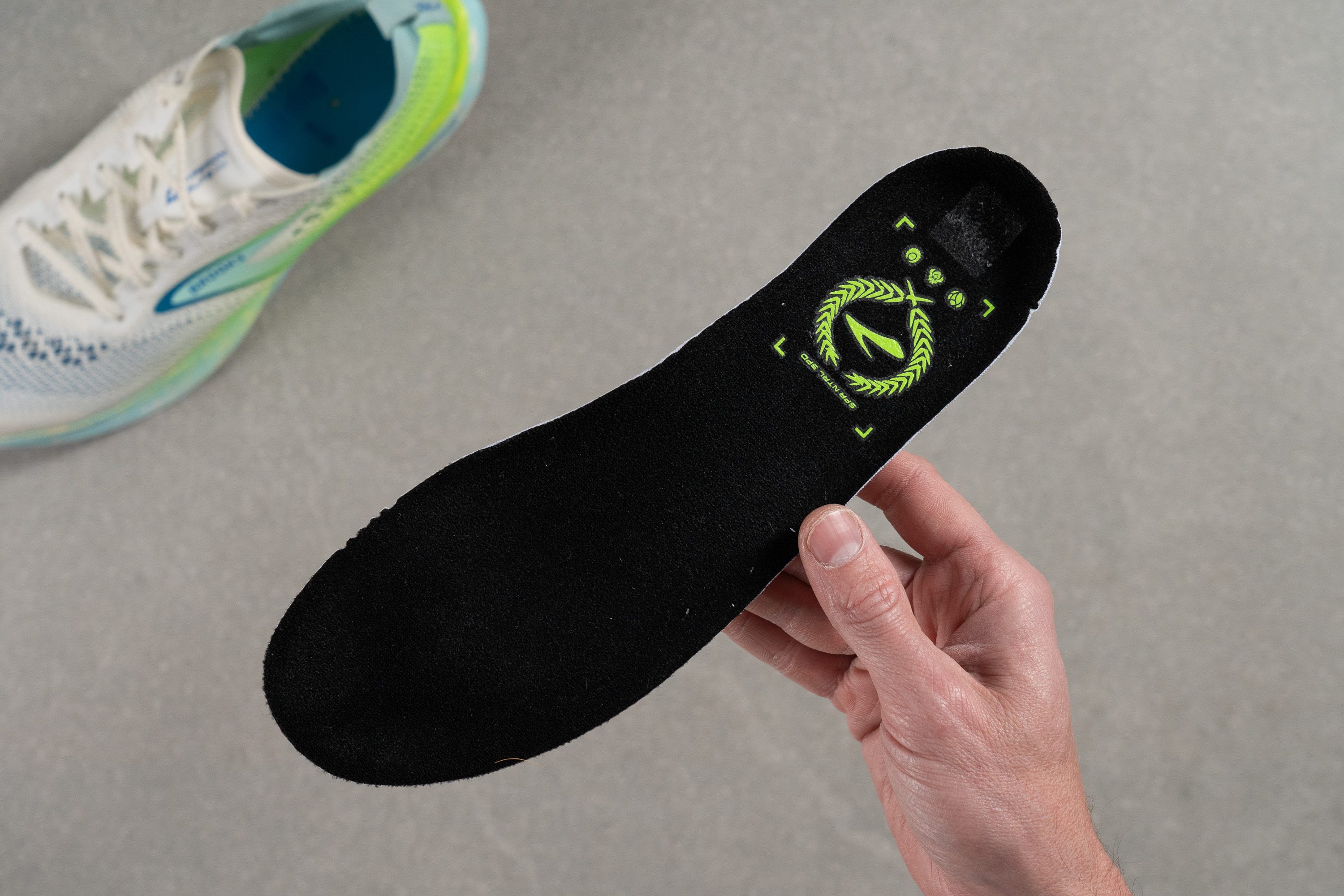
| Hyperion Elite 4 PB | Yes |
Midsole softness in cold (%)
One of the biggest strengths of PEBA is its ultra-consistent performance in cold temperatures. After doing our 20-minute freezer test, we discovered that while the Hyperion Elite 4 became 16% firmer, the new DNA Gold midsole changed by only 3%. Wow!
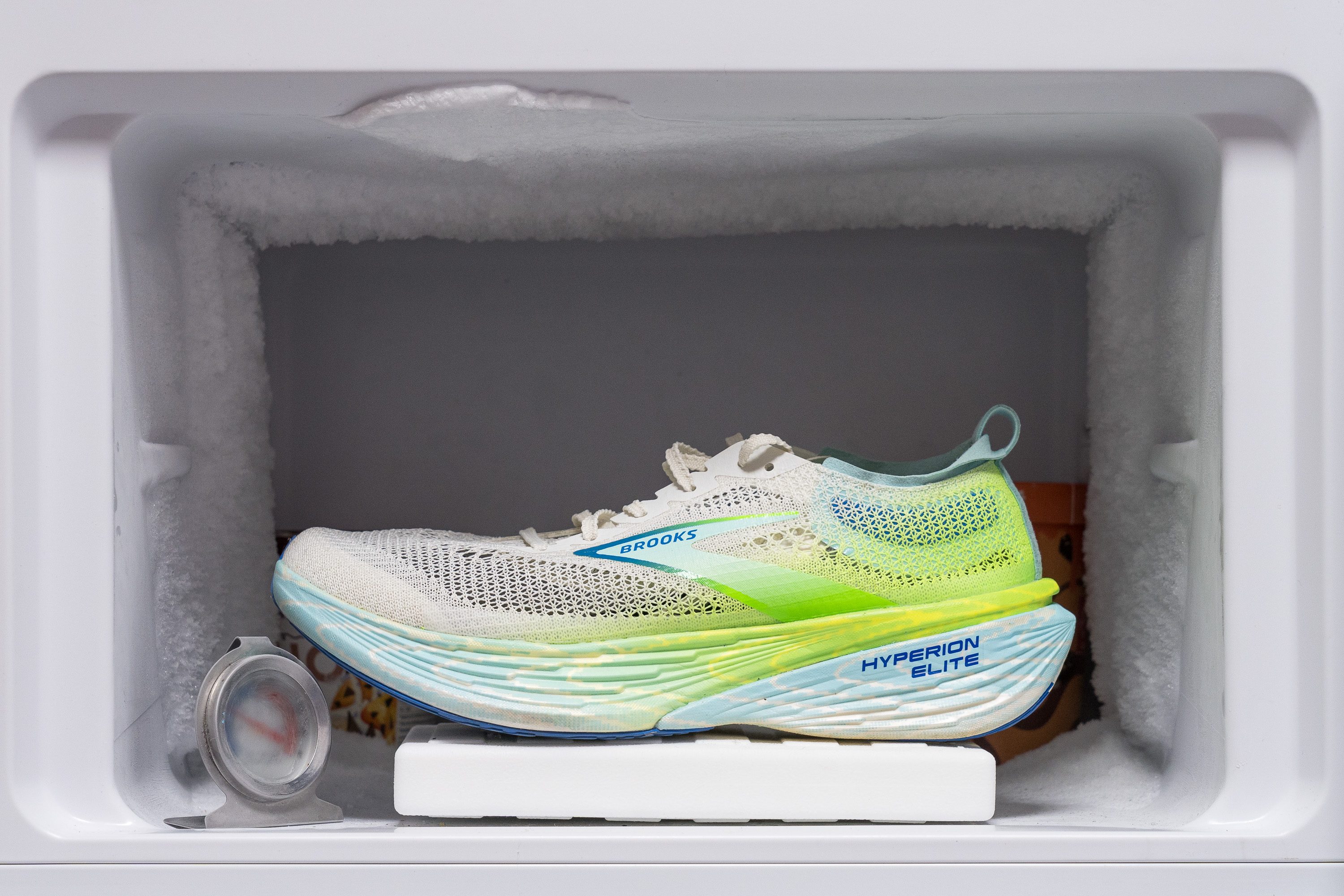
| Hyperion Elite 4 PB | 3% |
| Average | 24% |
Reflective elements
The Hyperion Elite 4 PB comes with zero reflective details—and honestly, we weren’t surprised. After all, almost nobody lines up for a race at night.

| Hyperion Elite 4 PB | No |
Tongue padding
The tongue on the Hyperion Elite 4 PB remains unchanged from the standard version, blending an ultra-thin shape with a cleverly-cushioned layer of foam that protects the instep without compromising the race-day feel we look for.
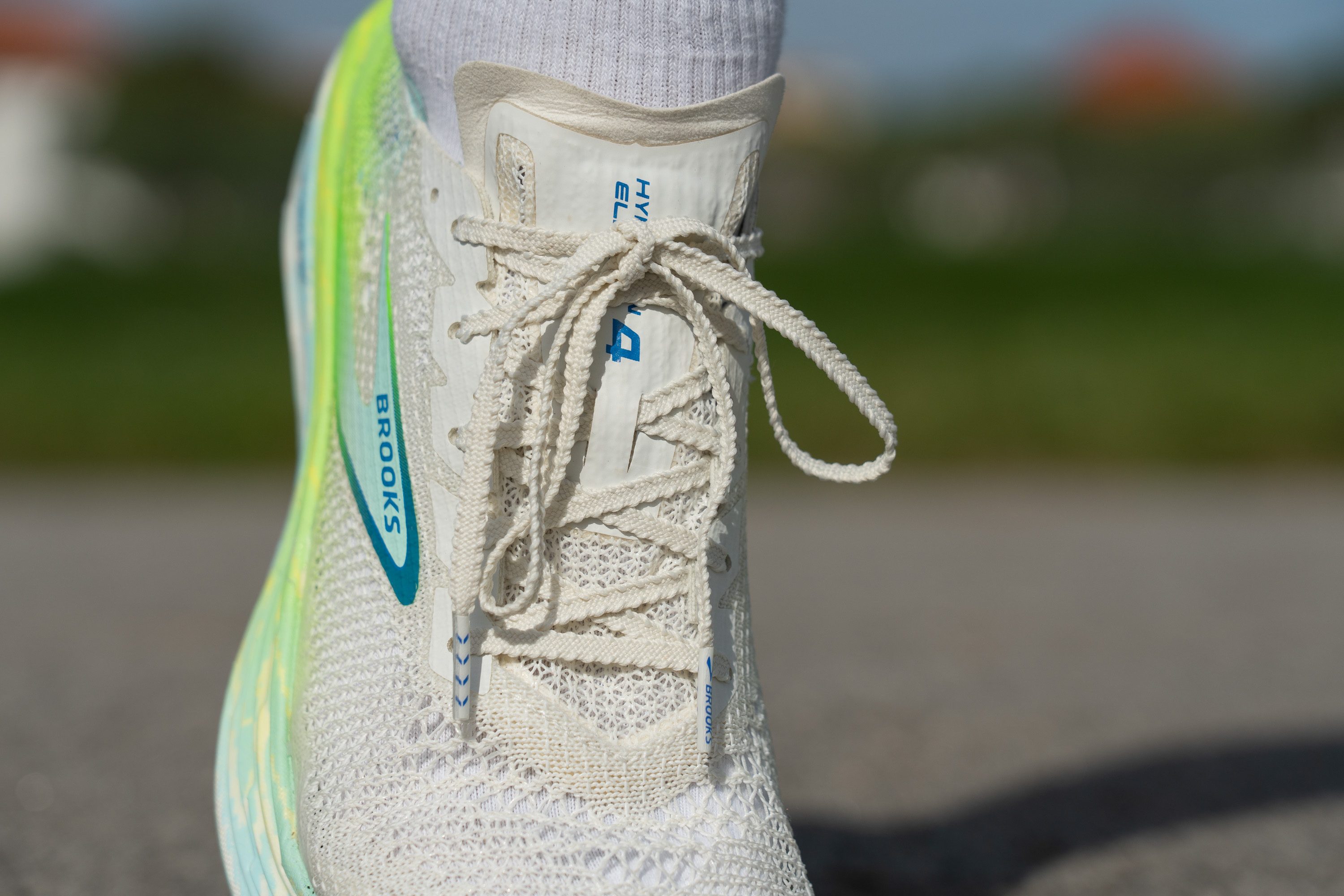
This comfortable design adds a bit of weight, but it’s a good alternative against most supershoes that stick with sub-2 mm tongues. We also tested the notched laces and found them to be a premium-grade detail that really enhances the lockdown, though we wished they were a bit shorter.
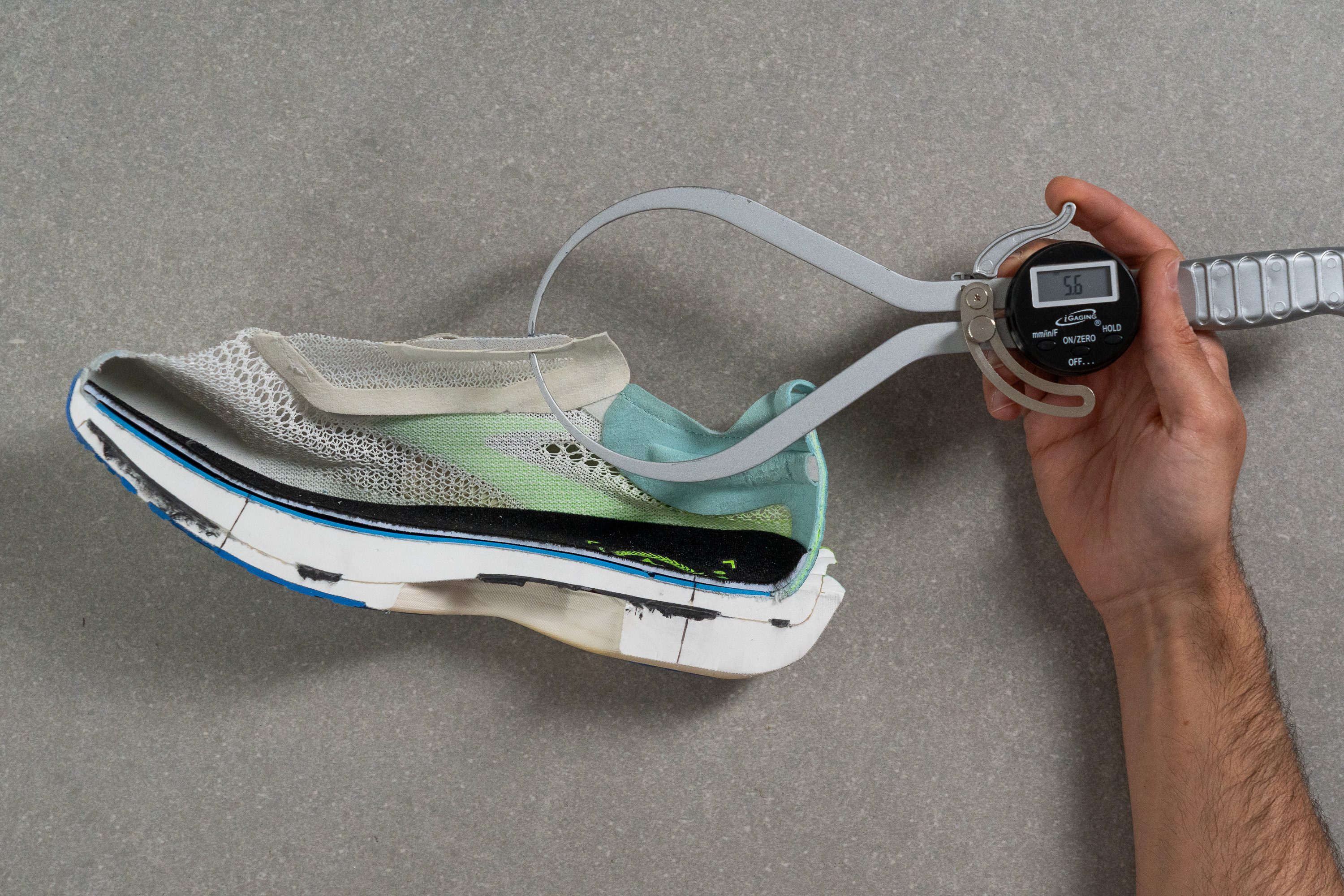
| Hyperion Elite 4 PB | 5.6 mm |
| Average | 5.8 mm |
Tongue: gusset type
Like many supershoes, the Hyperion Elite 4 PB uses a non-gusseted tongue—clearly a weight-saving decision. Thanks to the snug race-day lockdown and the added lace loop, we found that it stays perfectly in place.

| Hyperion Elite 4 PB | None |
Price
It was refreshing to see that Brooks didn’t raise the price for the PEBA upgrade—and honestly, it makes sense. The Elite 4 felt overpriced for what it offered, and this version finally corrects that. It still sits in the premium tier and it's okay to feel that it's a expensive shoe, but now it's aligned with most competitors in both price and performance.
| Hyperion Elite 4 PB | $250 |
Heel tab
The heel keeps the same design from the Hyperion Elite 4, featuring a finger-loop heel tab that adds a cool touch, though it can potentially rub some ankles.
We found that it also makes slipping the shoes on much easier and it's great for triathlon!
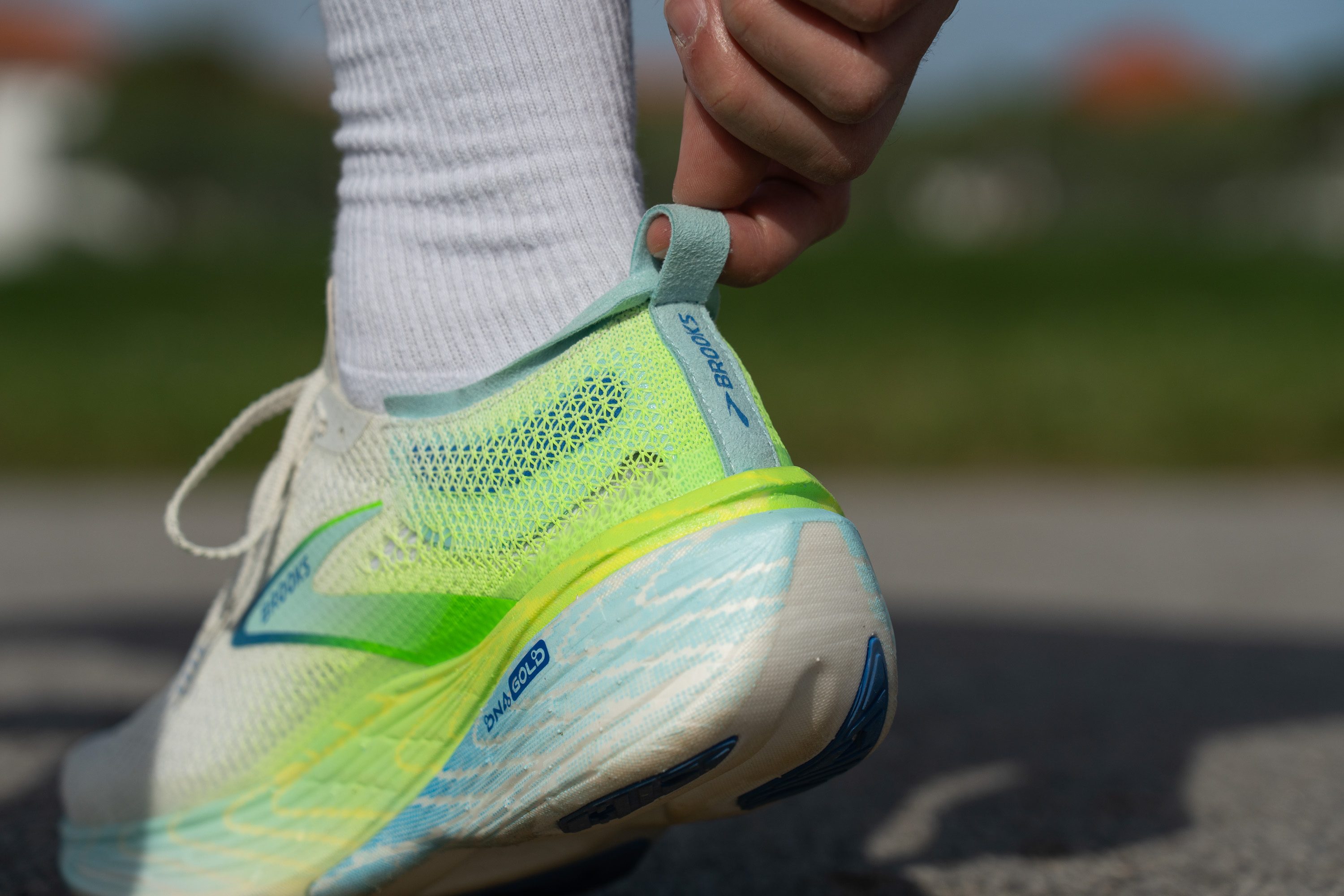
| Hyperion Elite 4 PB | Finger loop |

